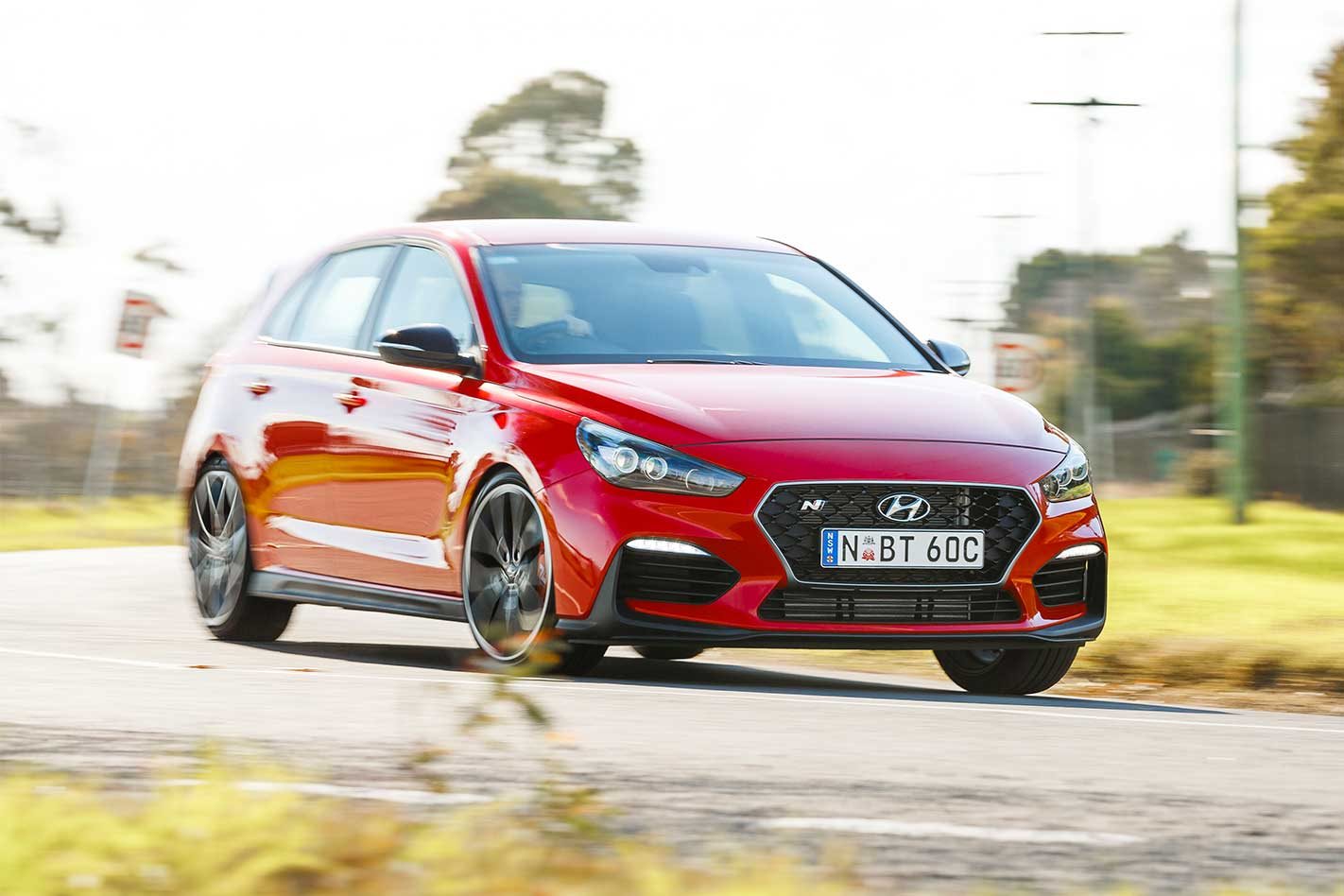- Introduction: A spicy serving
- Update 1: The nuts and bolts, examined
- Update 2: Performance tested
- Update 3: From M to N
- Update 4: Hillclimb hottie
- Update 5: Track star
- Update 6: Rallyin’ time
- Update 7: Conclusion
Introduction: A spicy serving
Occasionally in this job you can drive a car without driving it at all.
No, I’m not referring to some prototype autonomous system, rather circumstances dictate that you can get behind the wheel of a new model, yet be little wiser about what it’s actually like to drive.
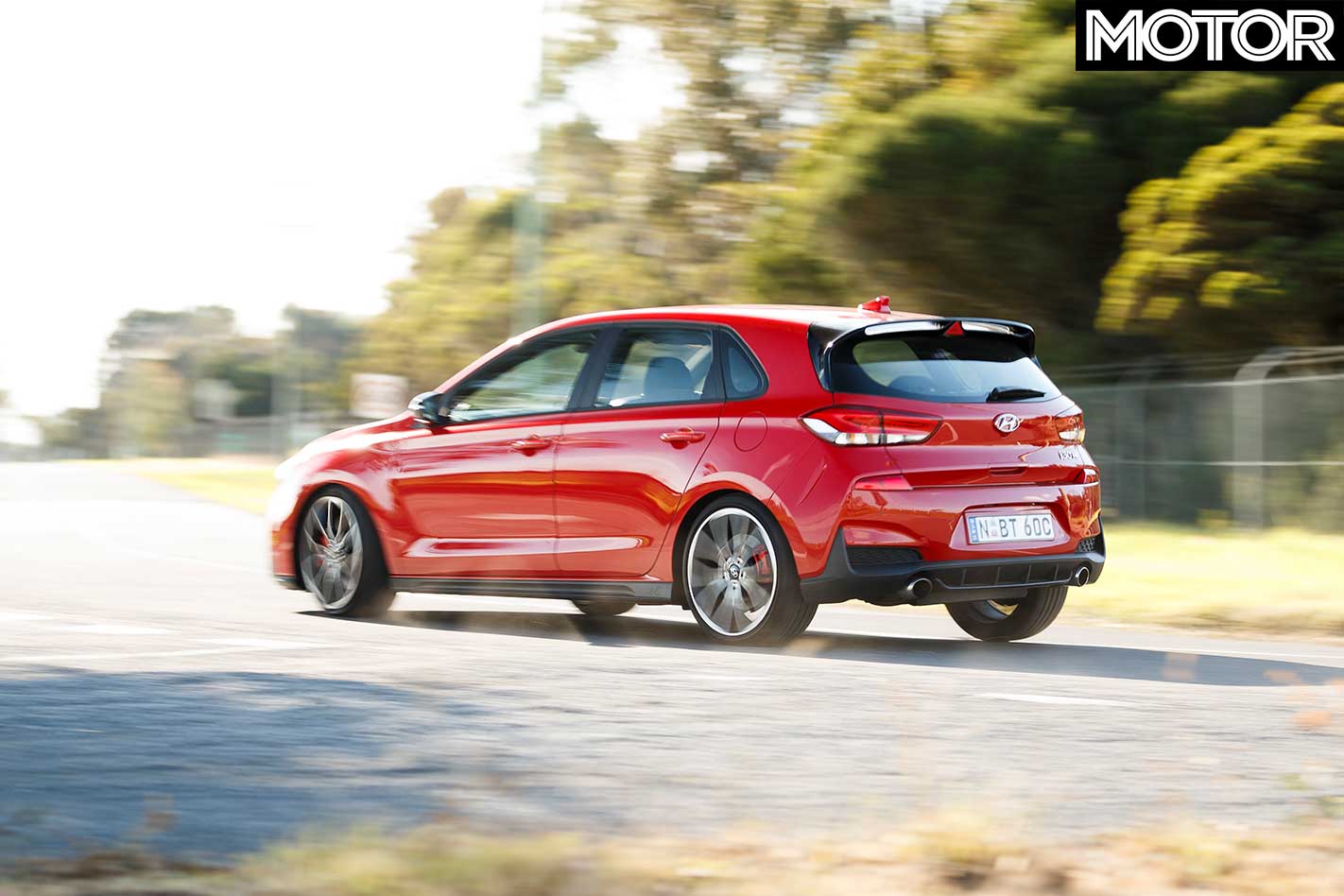
Personally, the Hyundai i30 N is the perfect example. I’ve actually driven it twice: once on a go-kart track during WRC Rally Australia last year and then again at Winton during this year’s Bang For Your Bucks testing. So if you asked me what an i30 N is like to drive I could give you an answer in a very specific set of circumstances, but if you wanted to know what it’s like to drive on the road, I’m afraid I wouldn’t be much help.
In six months’ time, however, hopefully I’ll be able to tell you all that and more, as Hyundai’s new hottie has joined the MOTOR garage for an extended stay. For now, let’s cover the basics.
Under the bonnet is a 2.0-litre turbocharged four-cylinder, which produces 202kW at 6000rpm and 353Nm from 1750-4200rpm, with 378Nm available from 1750-4200rpm on overboost for 18 seconds at a time. It’s perfectly square (86.0mm by 86.0mm), runs a 9.5:1 compression ratio and requires 95RON fuel.
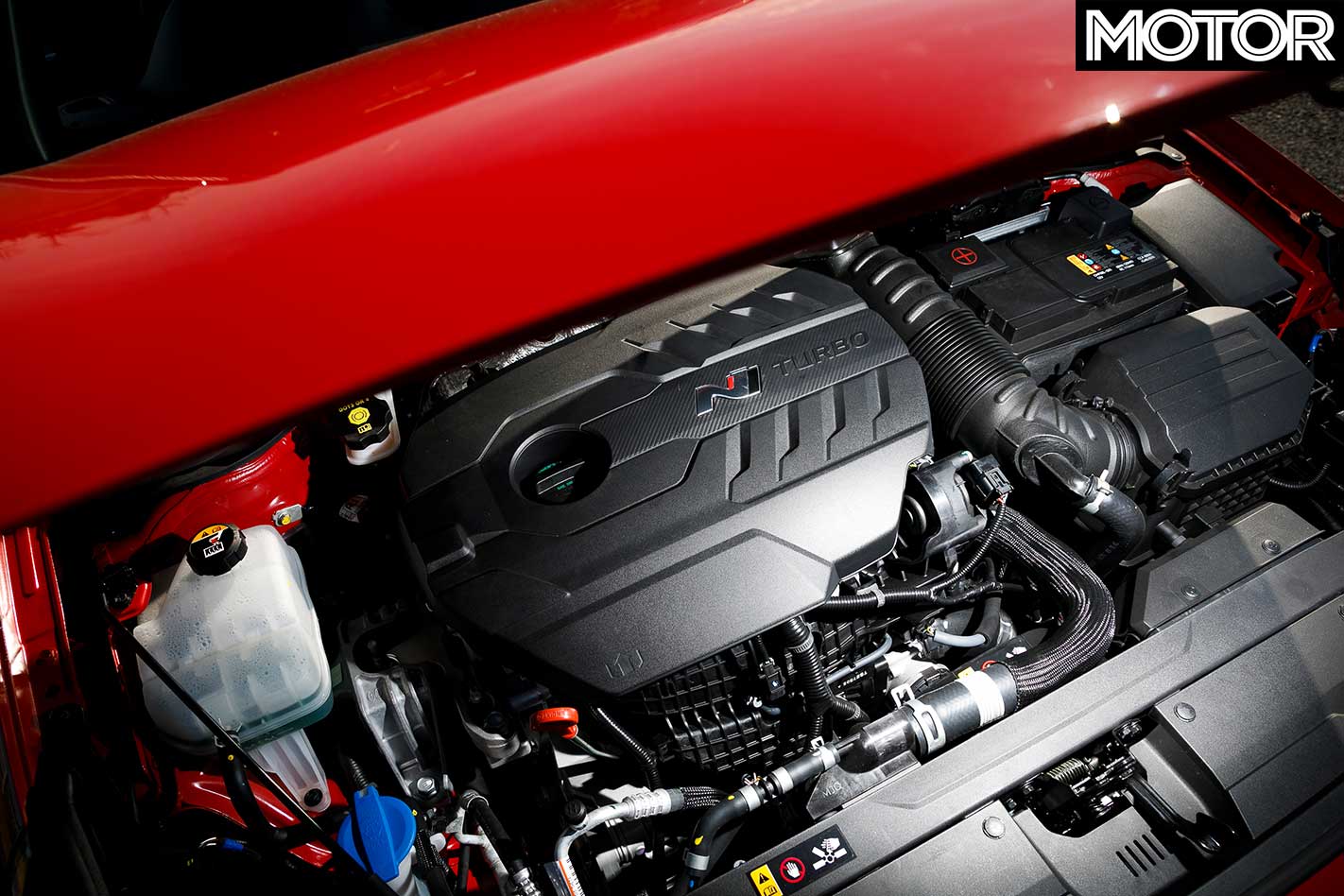
A six-speed manual is the only gearbox for now, though Hyundai is working on a dual-clutch, and power is fed to the front wheels through an electronically controlled mechanical limited-slip diff – no brake-activated faux-LSD nonsense here!
Suspension is MacPherson Strut front and multi-link rear with adaptive dampers all ’round and the wheels are 19 by 8.0-inch wearing 235/35 Pirelli P Zeros developed specifically for the i30 N (hence the ‘HN’ code on the sidewalls).
The steering is electrically assisted and stopping power comes courtesy of ventilated discs (345mm front, 314mm rear) with single-piston calipers at both ends, which Hyundai claims are sufficient to repeatedly haul the 1429kg i30 N up on track.
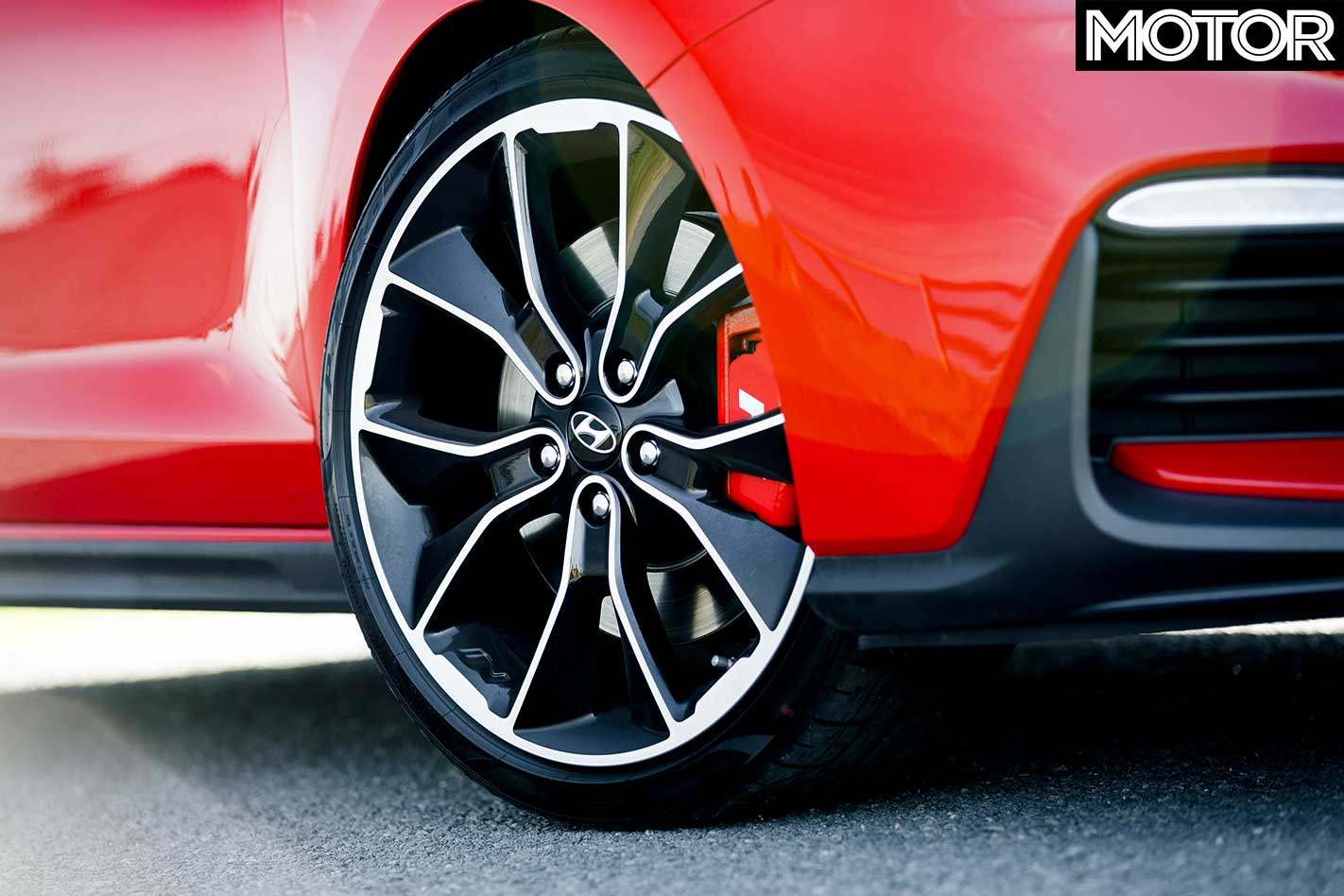
Overseas, a ‘base’ i30 N exists sans diff (along with smaller wheels, brakes, less power and no overboost) but after much deliberation Hyundai Oz decided to just offer the one mechanical specification with varying levels of interior kit.
‘My’ i30 N is as base as they come, its vivid Engine Red paint job (the best colour to my eyes) one of three solid colours, the others being Polar White and the Performance Blue hero colour. Opt for grey, slate or black and you’ll need an extra $495.
The $3000 Luxury Pack brings plenty of extra goodies, including heated 12-way power adjustable front seats, a heated steering wheel, park assist, keyless entry and go, wireless phone charging, auto-fold mirrors, rear privacy glass and more. Add another $2000 and you’ll score a panoramic glass sunroof. Will we miss this stuff? Time will tell.
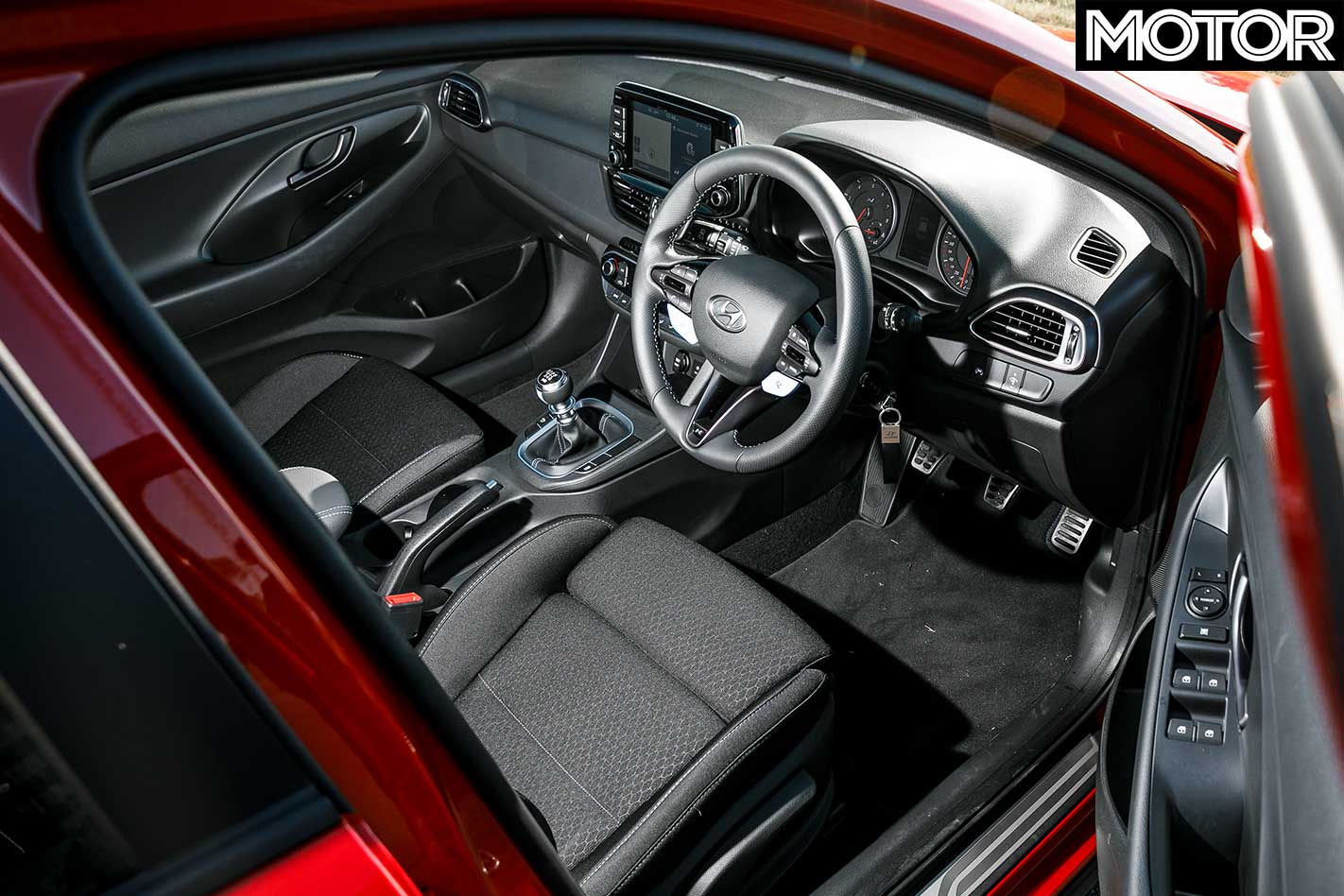
Happily, all the juicy mechanical bits are present and correct and it’s these bits we’re most interested in putting to the test over the next six months on road and track. There’s a lot to unpack, as the i30 N’s tremendous configurability – there are multiple settings for its engine response, rev matching, LSD, exhaust, suspension, steering and ESC – means there is a total of 1944 different combinations that can be saved to its ‘N Mode’ button.
To spend one minute in each you’d need to drive for more than 32 hours, which is one way to pass the time on a trip from Melbourne to Cairns. That’s not on the agenda, but plenty of other things are.
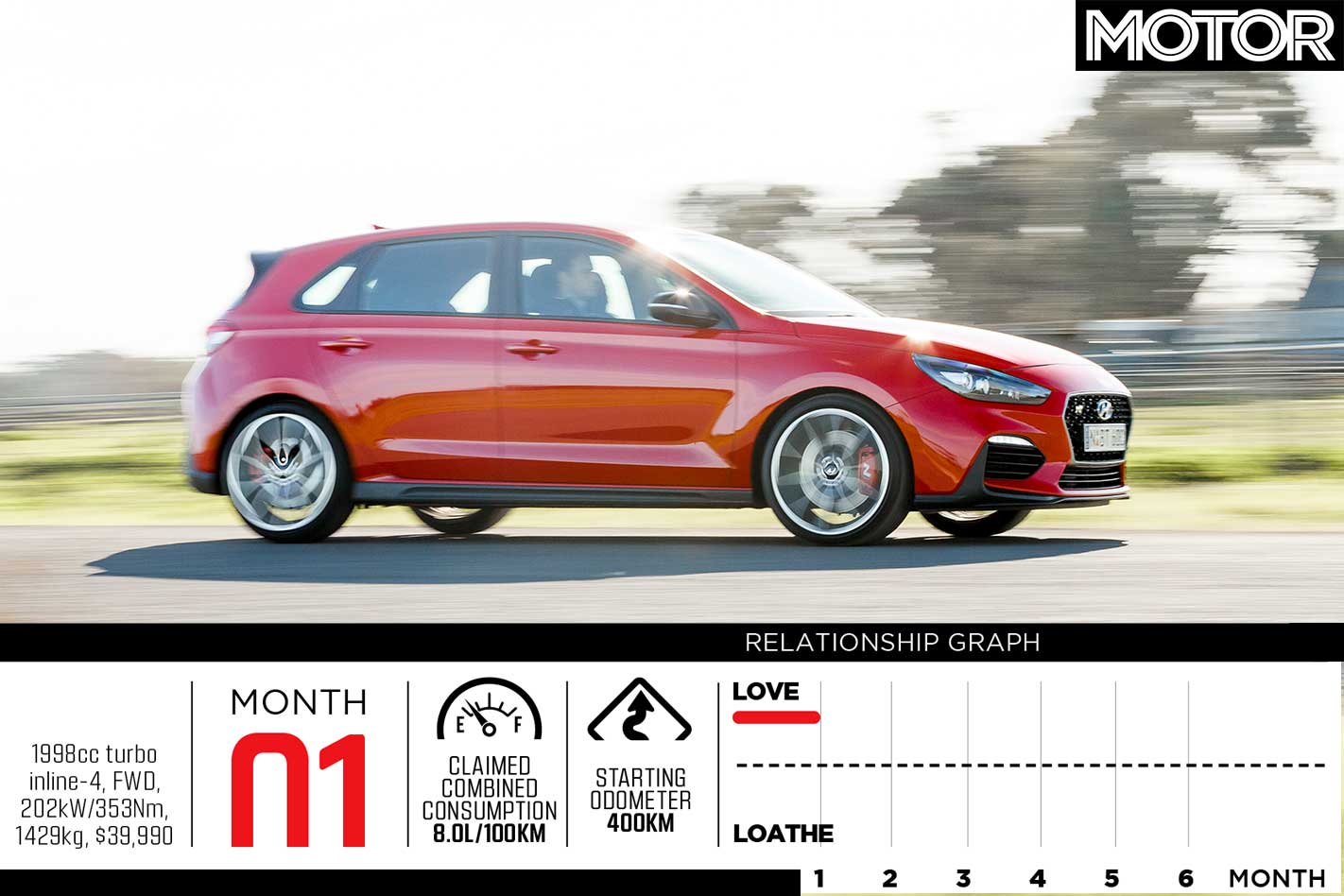
2018 Hyundai i30 N Pros & Cons
Three things we’re excited for: 1 – Track time 2 – Pops ’n’ bangs 3 – Heel ’n’ toe
Three things we’re nervous for: 1 – Lack of smart key 2 – Ride quality 3 – Liking it too much
Update 1: The nuts and bolts, examined

Hyundai Australia loves the i30 N. Of course, I’m sure it loves every car in its range (maybe…), but behind the scenes plenty at Hundee Oz are particularly excited to have a proper performance product in its range to promote and sell.
It wants to foster a community of N owners, setting up a number of ‘N Performance’ social media accounts to inform current and potential owners about every facet of Hyundai’s first true hot hatch.
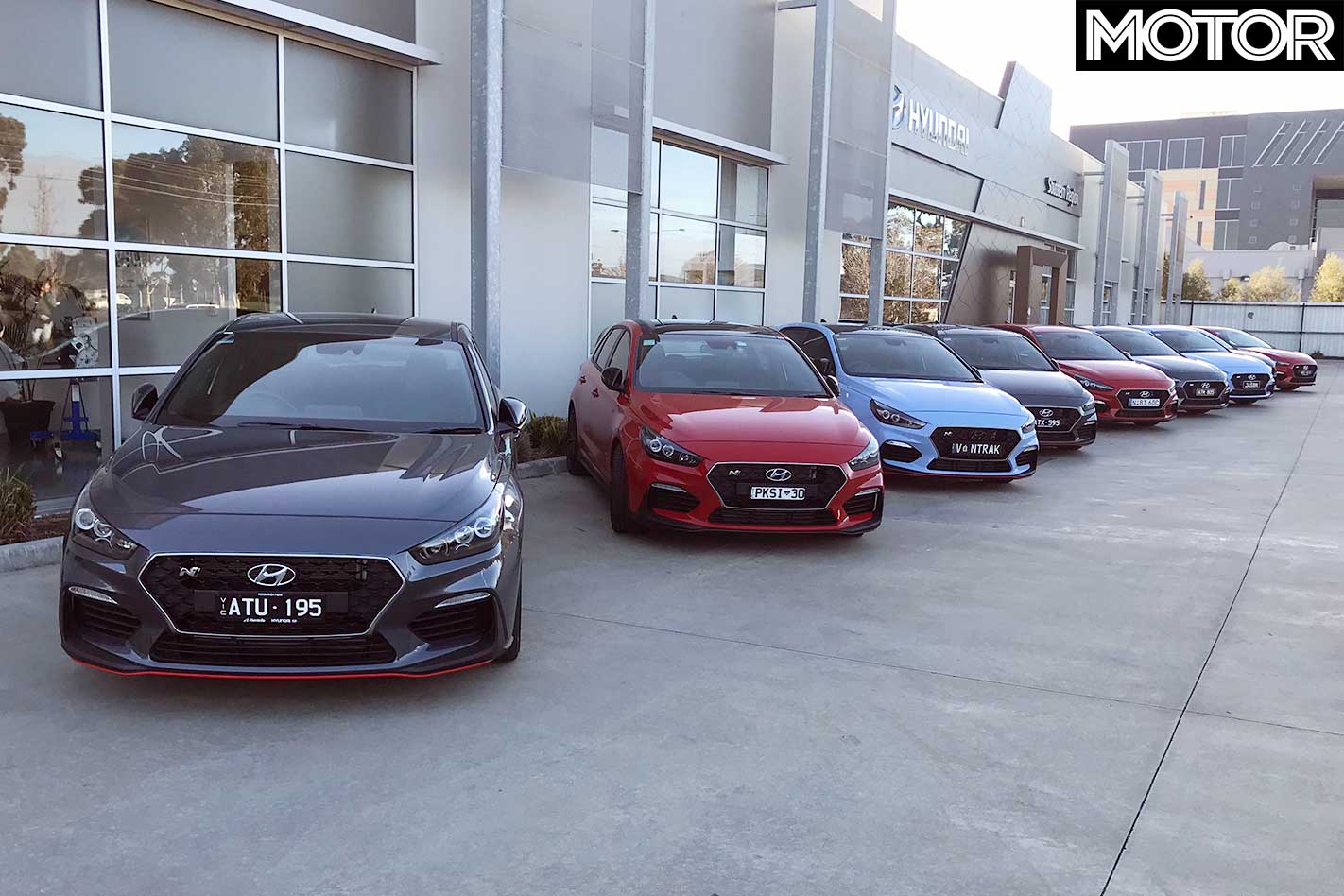
As part of this, workshops were recently held in Melbourne and Sydney, with technician Geoff Fear giving a presentation and taking questions. Thankfully, instead of a projector and Powerpoint there was an i30 N on a hoist and a number of disassembled N parts littered around to have a closer look at. Of course, as an i30 N ‘owner’ I had to head along, eager to learn more.
It turns out there is no such thing as a typical i30 N owner, customers ranging from young hot hatch fans to pension-age enthusiasts keen on one last performance car. Unsurprisingly, there were quite a few questions about tuning the i30 N, deftly batted away by the Hyundai crew, but refreshingly the bold addition of a track warranty had many punters intrigued and keen to head onto the speedy side of pit wall.
As one of the i30’s biggest markets, Australia had a bigger say in the development of the N than you might expect. So big, in fact, that local cars have not just a bespoke suspension tune, but unique dampers.
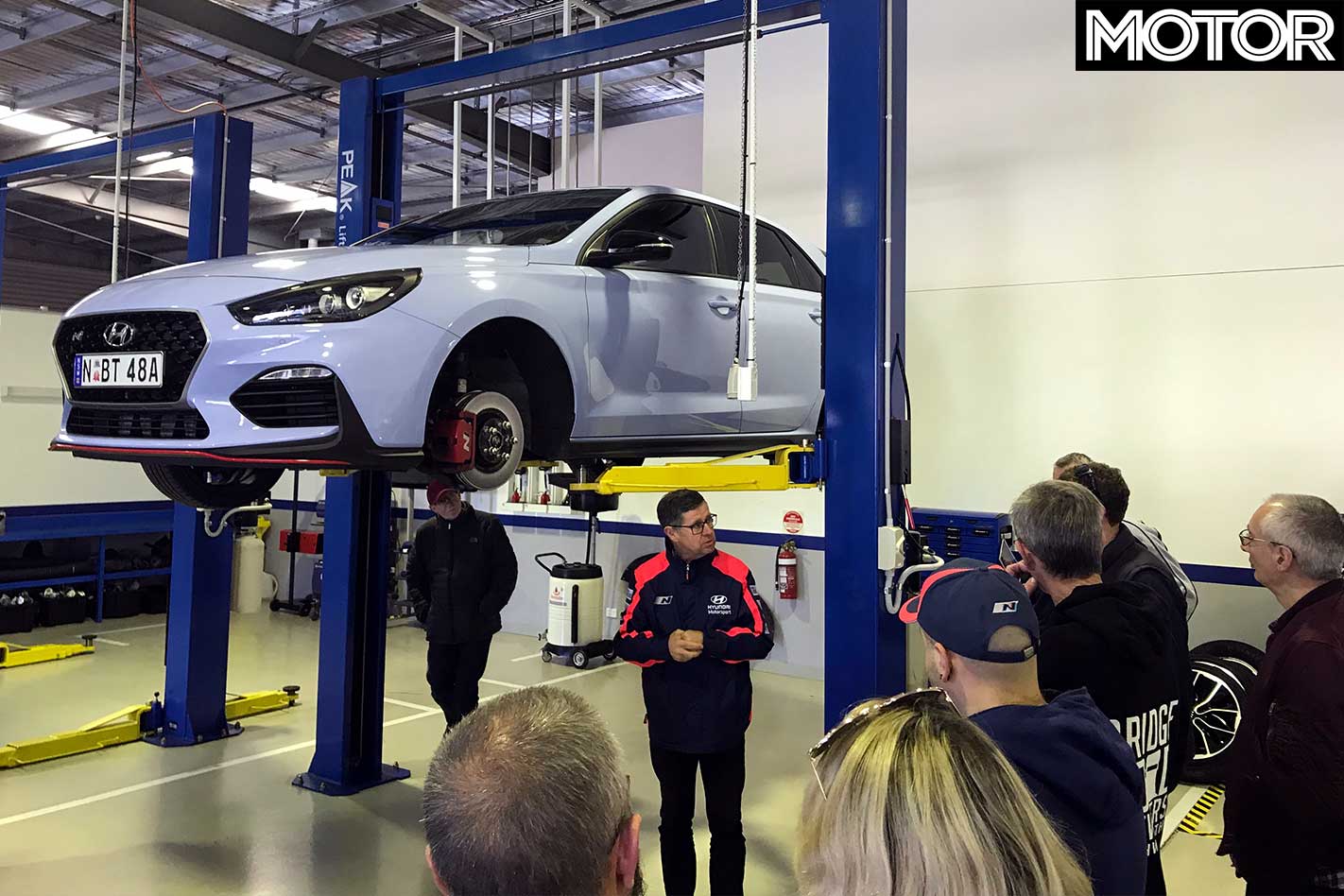
For this you can thank Australia’s crappy roads and our habit of driving over them at 100km/h regardless. Even in Normal mode, overseas Ns are set up quite stiff, Albert Biermann’s logic being that he wanted the car to feel instantly responsive, even on a short test drive. Trouble is, in Australia that responsiveness would likely translate into a sore bum in Normal and loosen fillings if you strayed into Sport Plus.
An Aussie-spec tune wasn’t an easy sell. It took Hyundai’s local engineers to drive Biermann around on a local visit to convince him the car needed to be softer to work on our roads.
Eventually, pothole after pothole had the boss onside: all Ns use the same springs and swaybars, but Aussie cars score different, softer damper internals, the extra compliance not only making the car more comfortable but improving its pace on country roads, too.
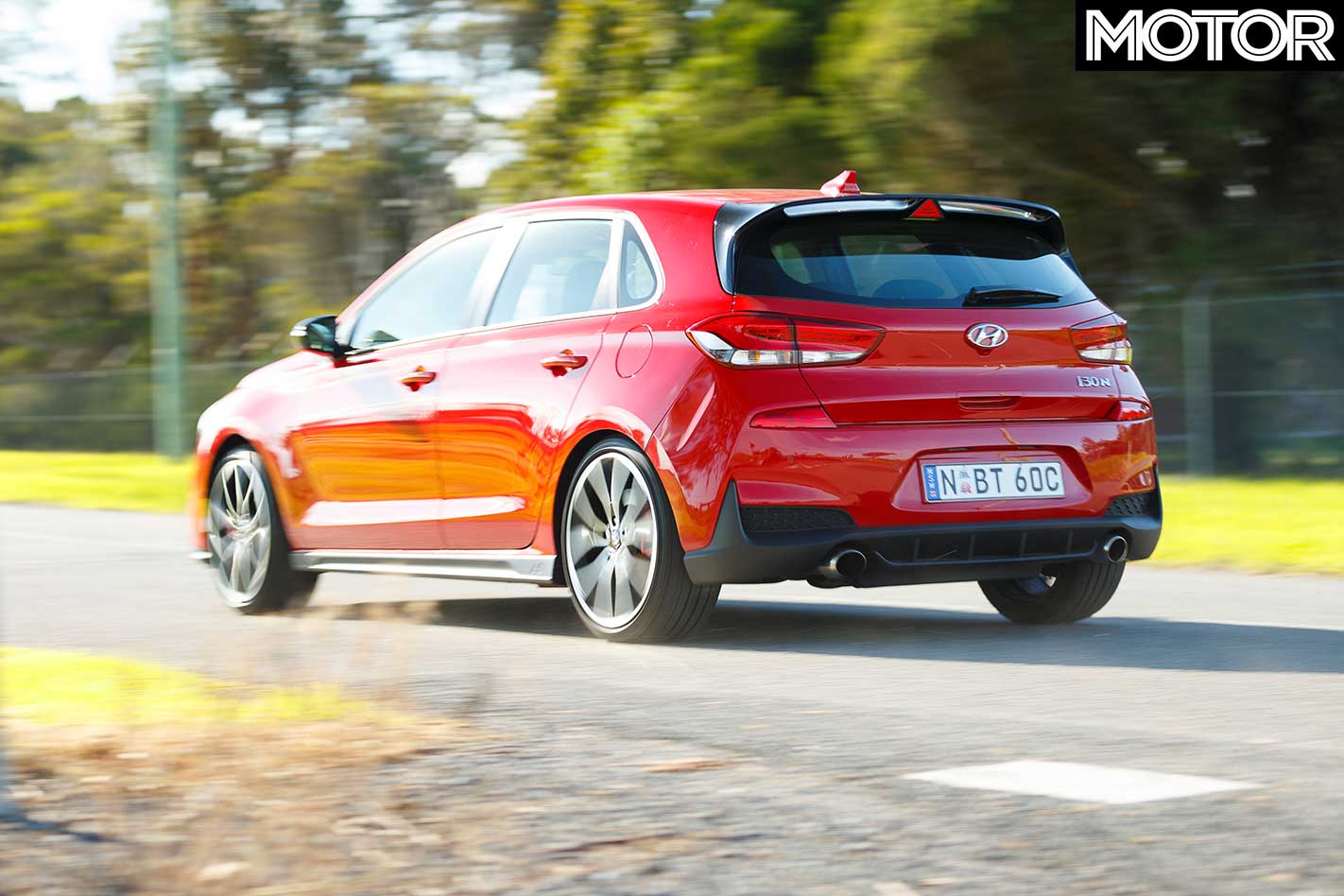
The job isn’t done yet – the goal is to go even softer. Don’t be surprised if the forthcoming i30 N Fastback has a little softer ride and likes a bit of tail-out attitude in the corners.
Other little nuggets of information: in Normal the exhaust operates only through the passenger-side tip; selecting Sport bypasses the muffler and uses the driver’s tip while also adjusting cam timing and injecting extra fuel to spark those signature pops and crackles. According to Fear, one engineer spent two years just working on the overrun theatrics.
In addition, if you’re going to change wheels, ensure the offset is identical to stock, otherwise you’ll alter the scrub radius (where the tyre contacts the tarmac). The i30 N is set up so the dead centre of the tyre is the contact patch; change the offset and you’ll affect this, changing your handling and tyre wear for the worse.
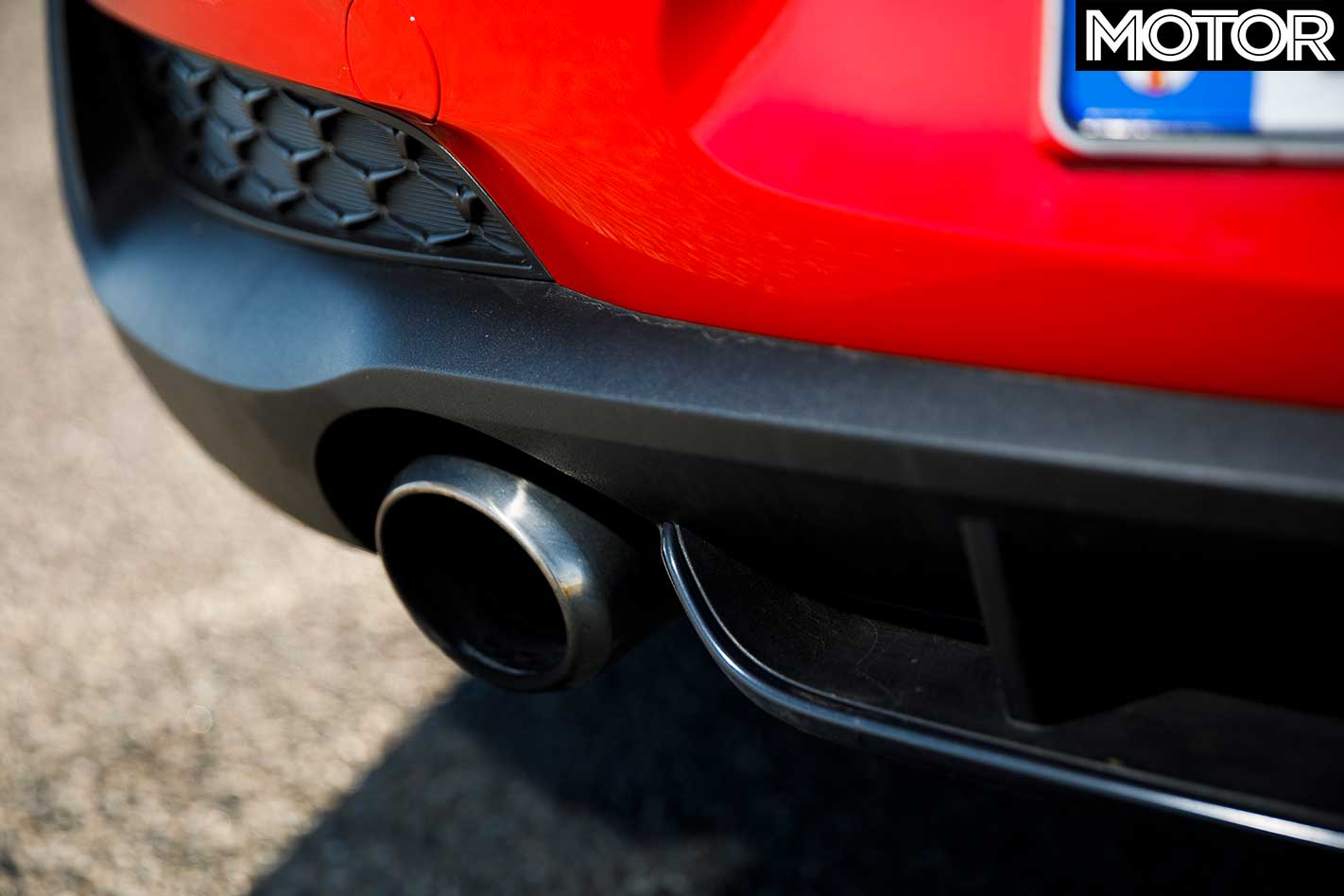
Use this month has effectively been adding some kilometres to the car before really stretching its legs – probably unnecessary, but old habits die hard. In day-to-day use I think the Hyundai Australia chassis folk are spot-on, it could use a little more ride compliance.
It’s an excellent compromise – if the car had passive dampers it would be about spot-on – but given the i30 N’s adaptive set-up, why not slacken off Normal more to accept the worst bumps and lumps? If you need the extra body control, that’s why Sport exists.
The turning circle is annoyingly large; at 11.6m it’s a metre larger than the regular i30, which it seems is just enough to make the difference between a successful u-turn and a three-point effort. Probably the biggest annoyance currently is the gearbox.
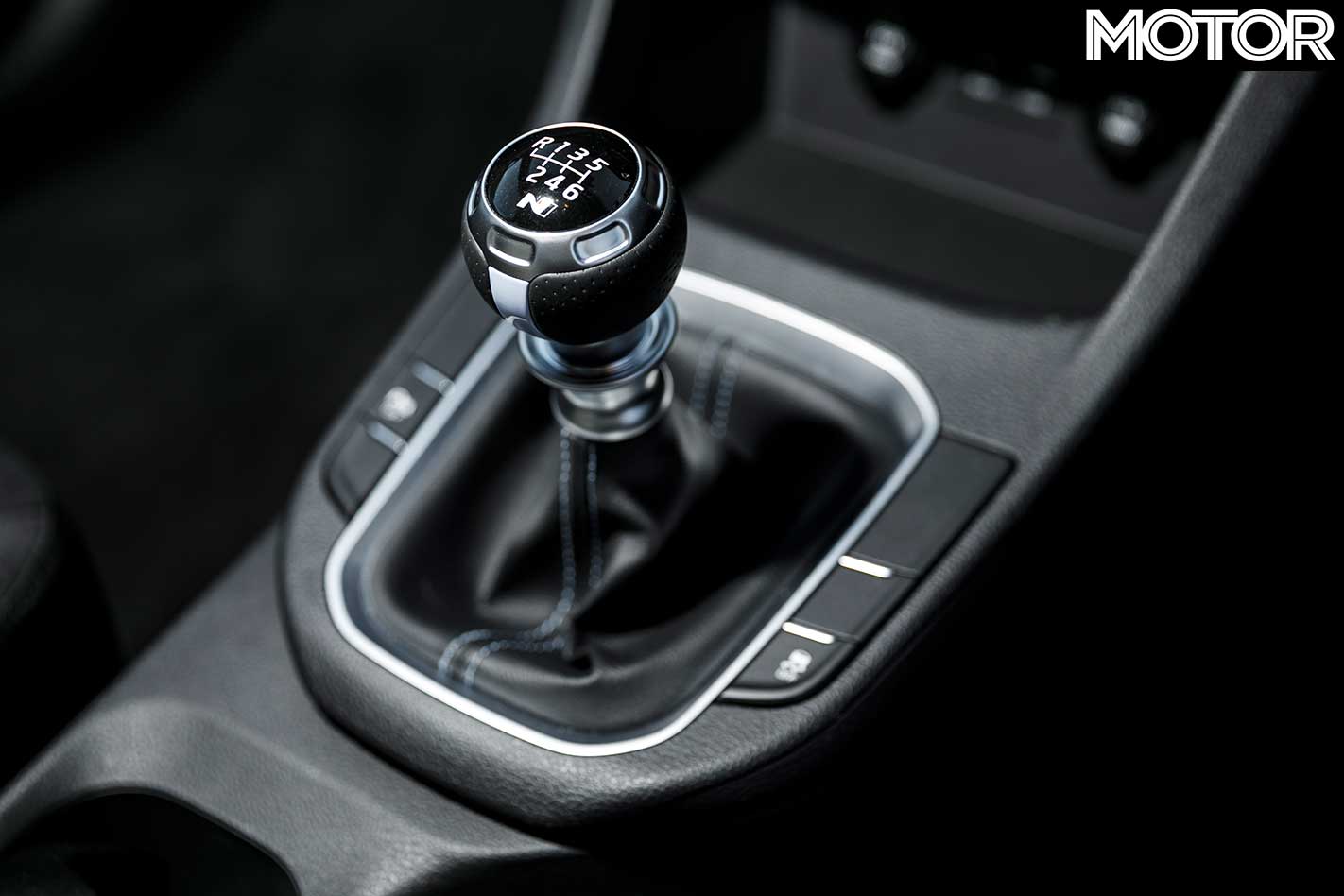
The shift is very notchy and sometimes baulks on the 5-6 change. It may be a cold oil issue, further investigation is needed, but getting back into the N after a day or two in a new manual Mustang, it’s the muscle car that has the superior gearchange. Stalling is also very easy, which is just bad driving, but some cars flatter you more than others.
That’s virtually it for the bad stuff – this is a very easy car to live with. That said, I already know if it were my money I’d be speccing the Luxury Pack, if only for the smart key and push-button start.
Keyless entry makes life so much easier when you have arms full of shopping, etc. For $3000, it also adds heated front seats and steering wheel, powered front seats with suede inserts and leather bolsters, front park assist and more – seems good value.
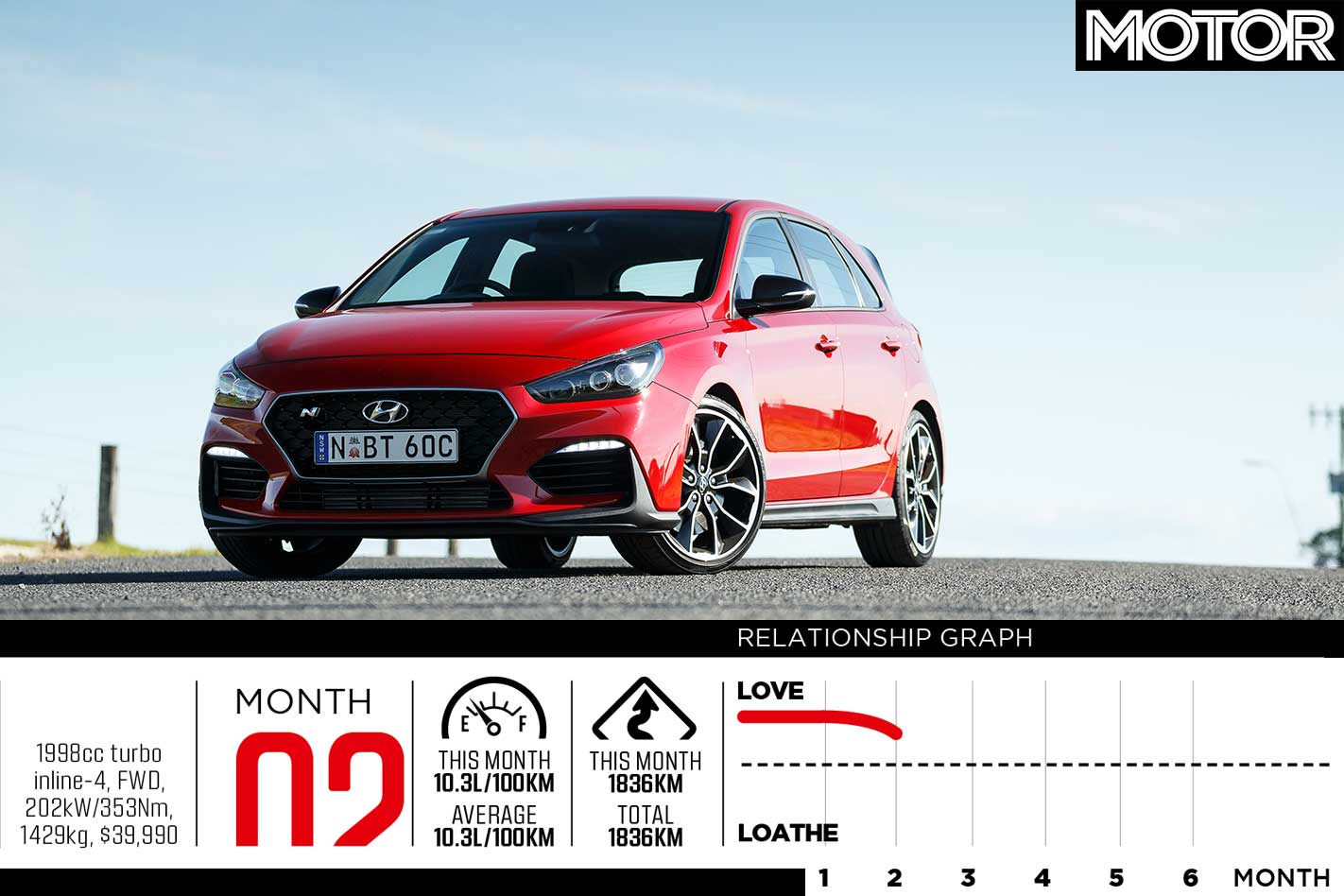
2018 Hyundai i30 N Pros & Cons
Three things that we’re rating: 1 – Grunty engine 2 – Seat comfort 3 – Apple CarPlay
Three things that are grating: 1 – Shift quality 2 – Turning circle 3 – Stalling a lot
Update 2: Performance tested
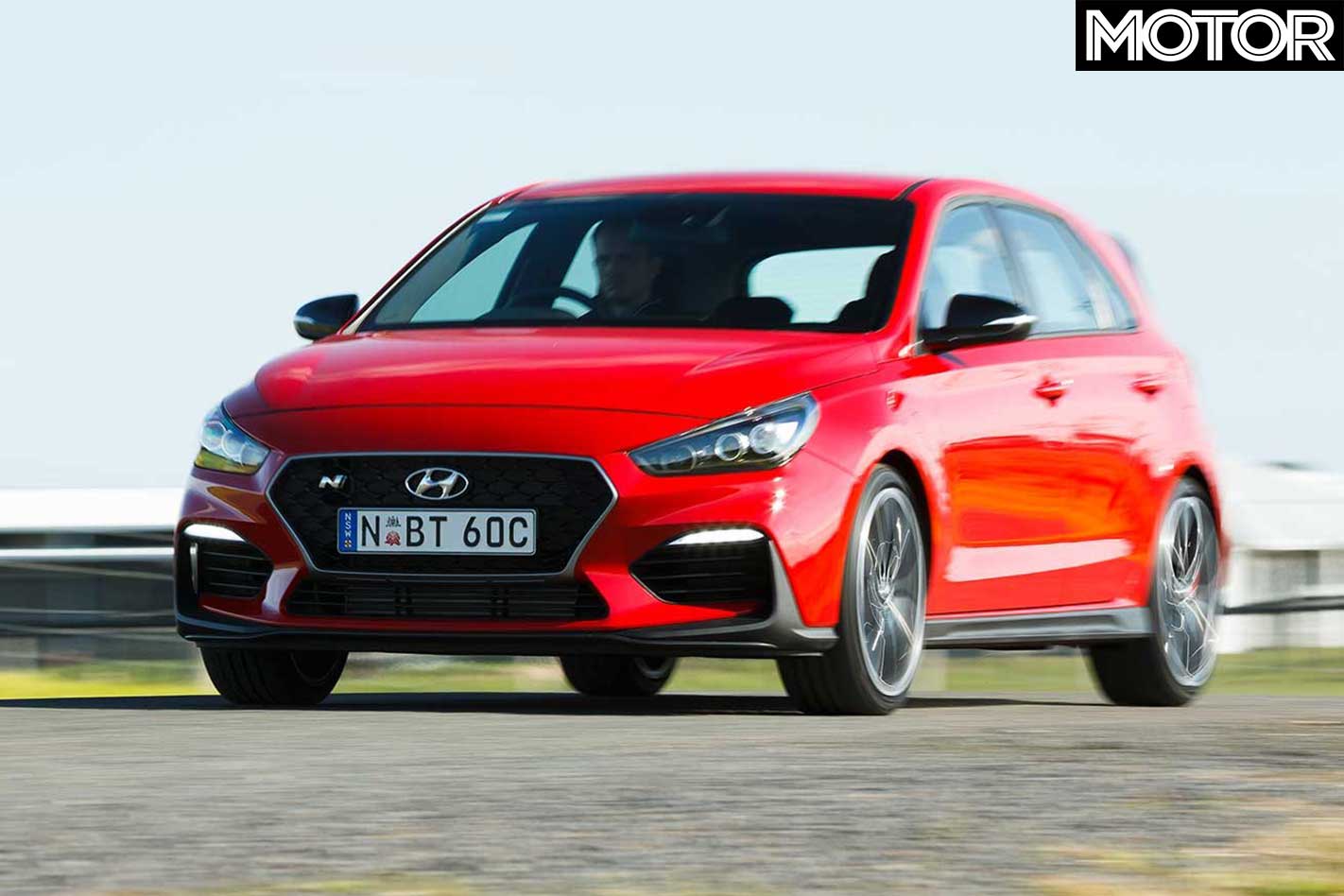
Hot hatches are all about handling. Except they’re not.
Straight-line acceleration might not be as high a priority for fast five-door buyers as, say, those looking at muscle cars, but drag-strip bragging rights are still valuable. Given the i30 N faced the 400m this month for the comparo you can read in the latest October 2018 issue, it seems appropriate to dig into the numbers in a little more detail here.
Hyundai claims 0-100km/h is achievable in 6.2sec. It is, but it’s not an easy task. Like most turbo front-drive hatches, the i30 N has traction issues, but what is unusual is that loss of traction isn’t the problem. Instead, pesky non-switchable traction control prevents the Namyang native putting its best foot, ahem, wheel forward.
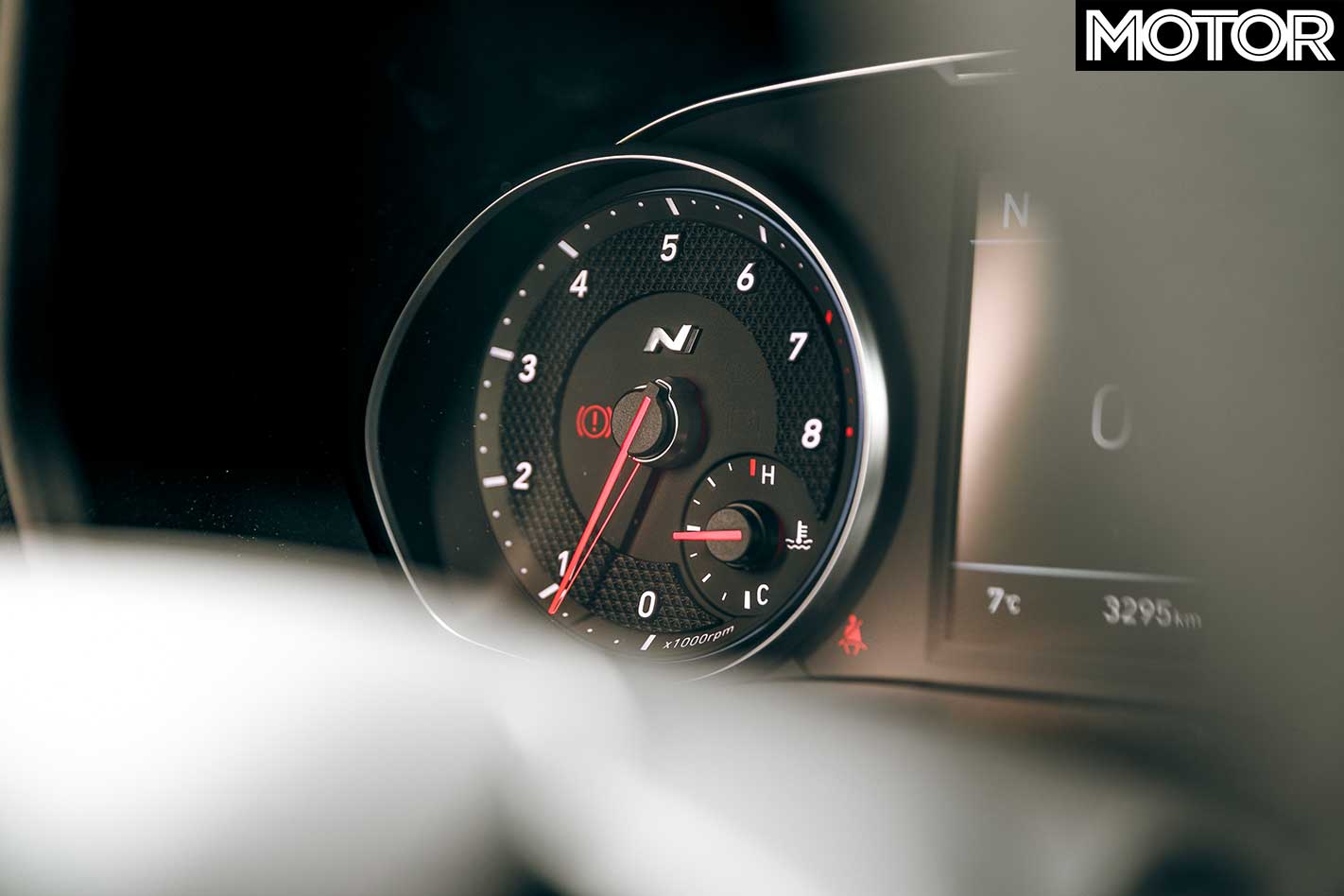
The best way to launch most force-fed front-drivers is to have the front tyres rotating slightly faster than road speed. It’s a delicate balancing act, as too much throttle wastes time through excess wheelspin, while too little lets the engine bog and boost disappear, at which point you might as well pull the handbrake on and get out, the time will be that bad.
Of course, zero wheelspin would be even better, but is also virtually impossible when feeding turbocharged torque through just the front tyres alone.
Unfortunately, this time-tested approach is impossible thanks to the i30 N’s overzealous traction control program, a frustrating trait it shares with Golf GTIs.
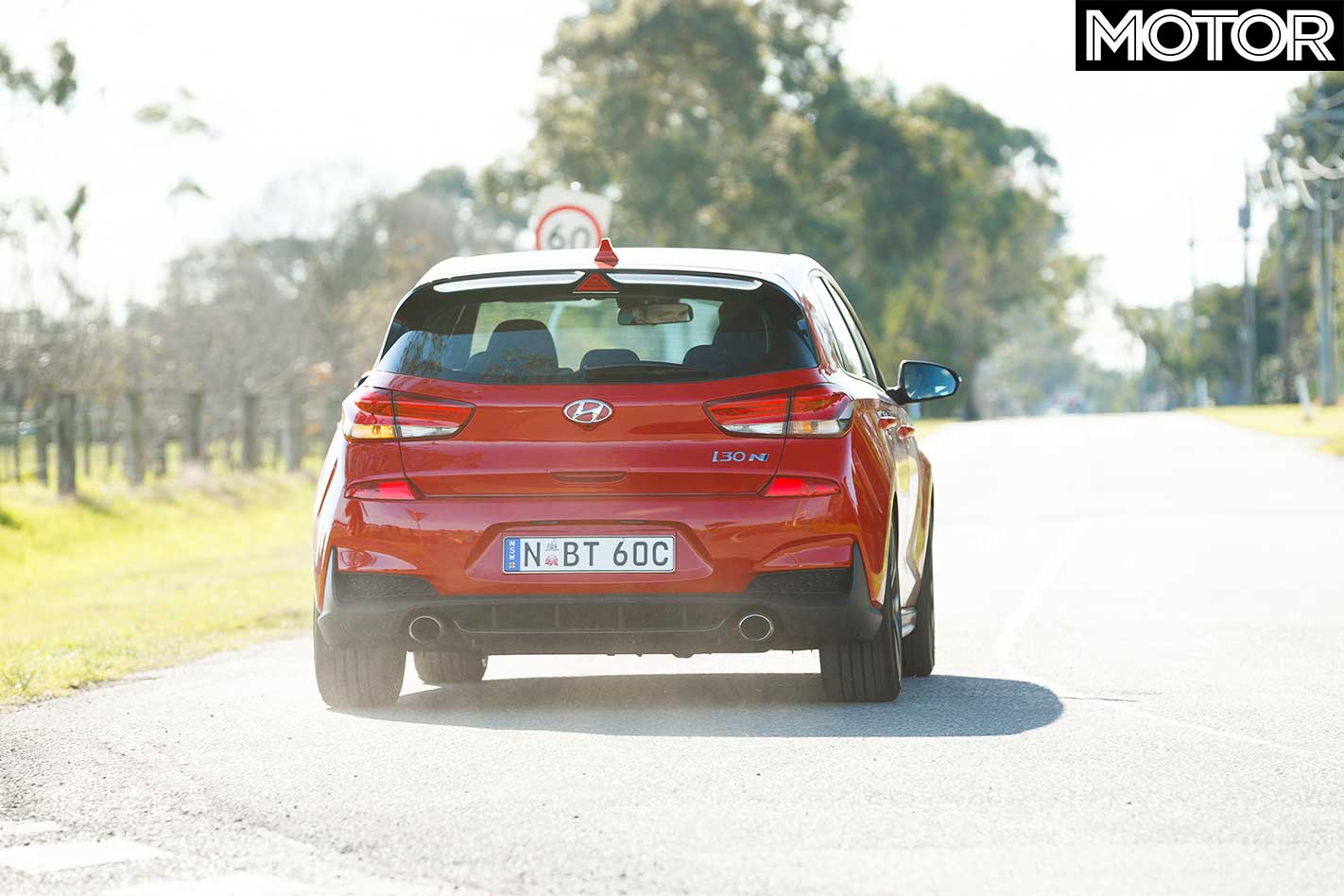
Despite deactivating every possible electronic aid, each launch results in a telltale orange light flashing on the dash (to the left of the ESP light if you’re curious). The intervention is only brief, but it’s enough for the engine to pause and precious tenths to tick away.
It’s difficult to understand why this would be the case, as Hyundai is happy for ESP to be deactivated completely and let the driver hang the tail out to his or her heart’s content. The answer isn’t certain, but someone who would know suggested it’s a durability measure to prevent excess axle tramp, which would explain why the Golf would have similar protection in place.

Hyundai’s hottie is further hamstrung by gearing designed to ace the European 0-60mph (0-97km/h) benchmark. Try as you might, nothing will make the i30 N reach 100km/h in second gear, the rev limiter cutting in at 99km/h. Worse still, third gear is quite tall (stretching to 149km/h) so progress is slowed further.
Nonetheless, get everything right and the result is 6.24sec to 100km/h. It must be said that this number was an anomaly, most runs being a few hundredths either side of 6.5sec, but for one run the electronics looked the other way long enough for most of the i30’s 202kW and 353Nm to be put to good use.
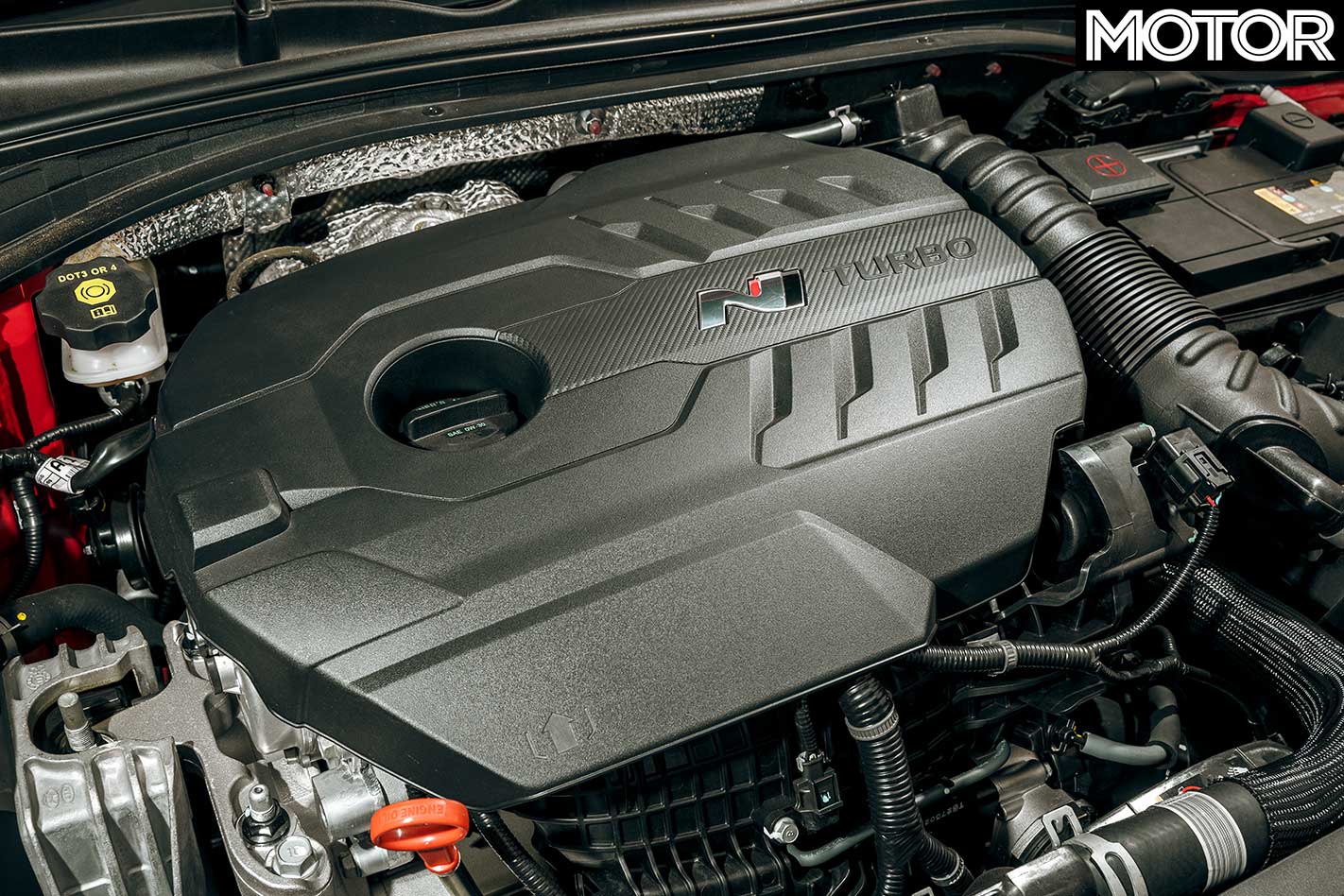
The N doesn’t feel as quick as its outputs suggest. Its 2.0-litre T-GDi engine performs very strongly from 4000-6000rpm, but power drops off dramatically beyond this as its turbocharger runs out of puff.
It’s not an issue on the road, for the broad powerband provides a wide river of torque in which to swim, but in the extreme environment of performance testing (or on track?) these things are noticeable. That said, we all know hot hatches are all about handling, which we’ll investigate next month.

2018 Hyundai i30 N Pros & Cons
Three things that we’re falling for: 1 – Mid-range grunt 2 – Quick gearshift 3 – Bang, pop, bang
Three things that we’re not fond of: 1 – Traction control 2 – Gearing issues 3 – Power drop
Update 3: From M to N
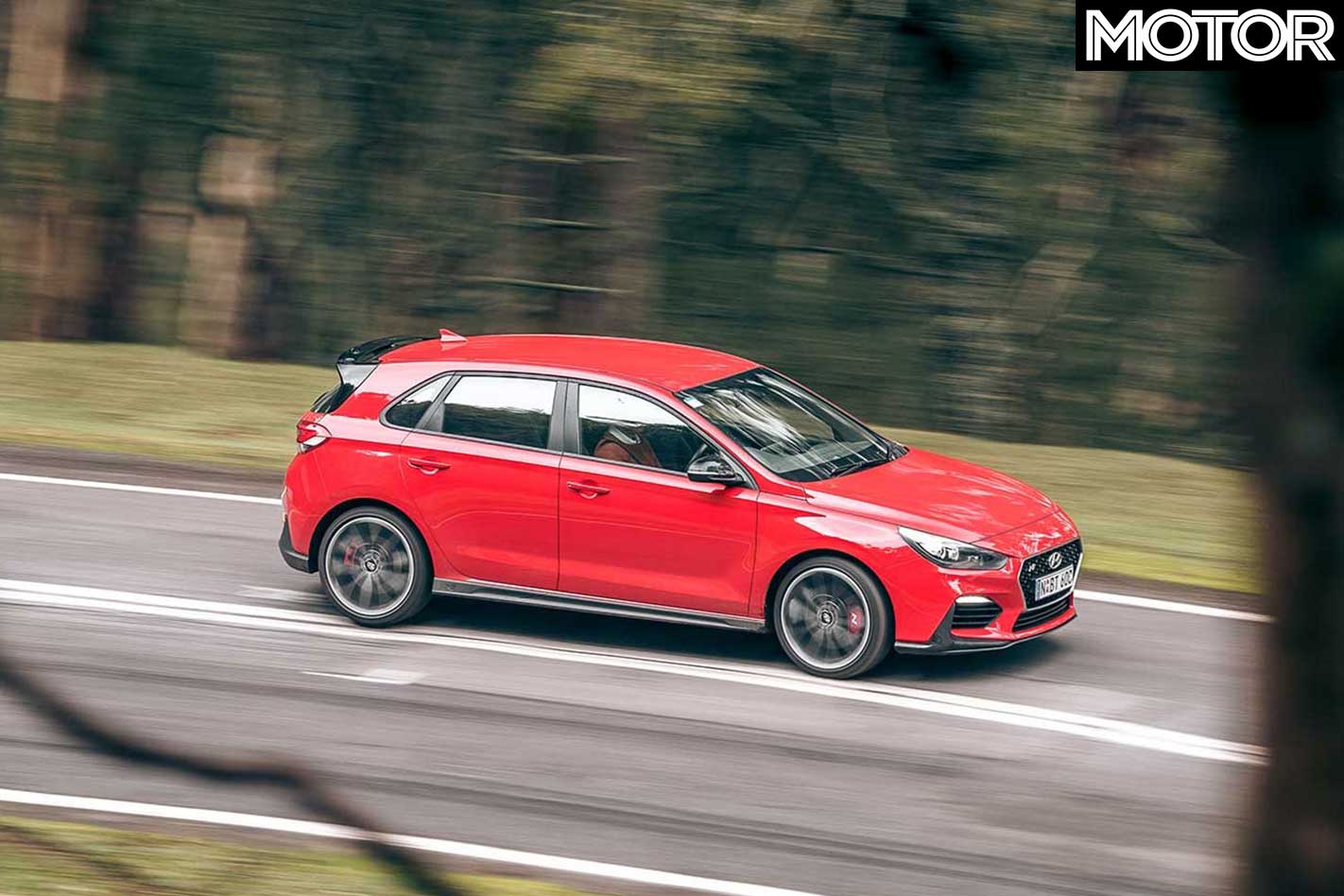
Albert Biermann relocated half way around the world to move next door. Alphabetically next door, that is.
Regular readers will probably be aware that before he became Executive Vice President for Vehicle Testing and High Performance Development at Hyundai and Kia, Biermann was a BMW veteran of 32 years, climbing the corporate ladder to the very top rung as head of M Division.
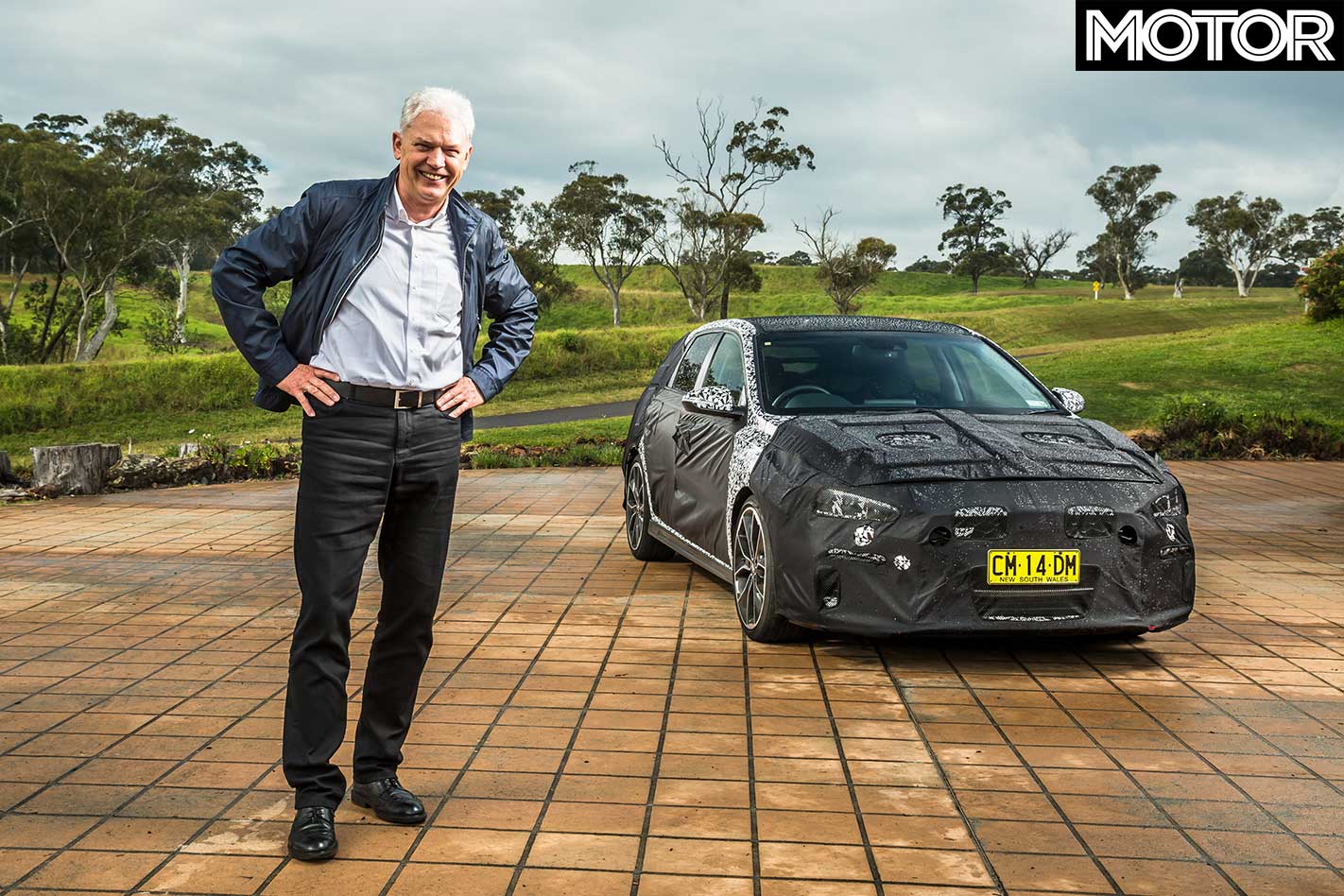
In April 2015, Biermann relocated from Munich to Namyang and subsequently moved from M Division to N Division. Anyone familiar with recent BMW M products will soon notice Biermann’s fingerprints all over the i30 N.
While hundreds of engineers were involved with the development of Hyundai’s first hot hatch, as project leader Biermann had the final say and it’s clear he’s carried certain development philosophies with him, philosophies that were no doubt a large part of the reason Hyundai-Kia poached him in the first place.
The i30 N’s USP is its almost endless configurability. Steering weight, damper stiffness, engine response, diff actuation, exhaust note and more can all be adjusted through either two or three different settings. I once asked an M engineer why all these modes were offered – surely it would be better to just offer one ‘correct’ mode?
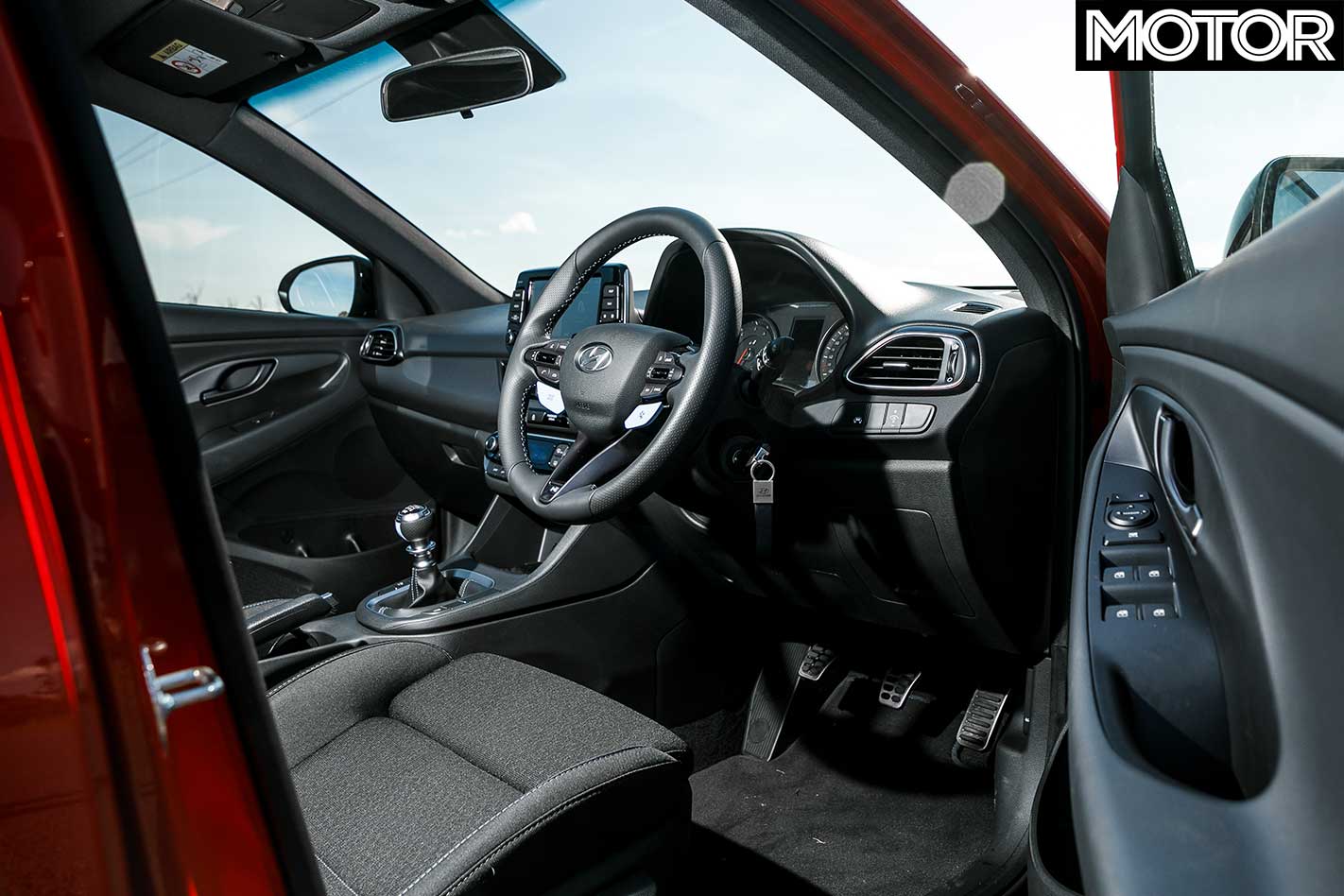
He explained that customers enjoy them, there’s no ‘cost’ in offering them – ie, you don’t have to sacrifice anything on the engineering front – and there’s value in the ability to have, for example, heavier steering at autobahn velocities compared to parking speeds. Fair point, but the approach only really works if there’s a ‘one-size-fits-all’ setting that suits the majority of driving scenarios without the need to constantly alter settings.
Thankfully, the i30 N by and large pulls it off. For day-to-day driving my preference is to leave everything more or less in its default mode; about the only changes I ever make are occasional forays into Sport if I’m feeling inspired or a press of the REV button on the steering wheel if I’m feeling lazy and can’t be bothered blipping my own throttle on downchanges.
Hyundai has successfully offered the ‘ultimate’ setting that means I can get in and drive without the need to hit a bunch of buttons.
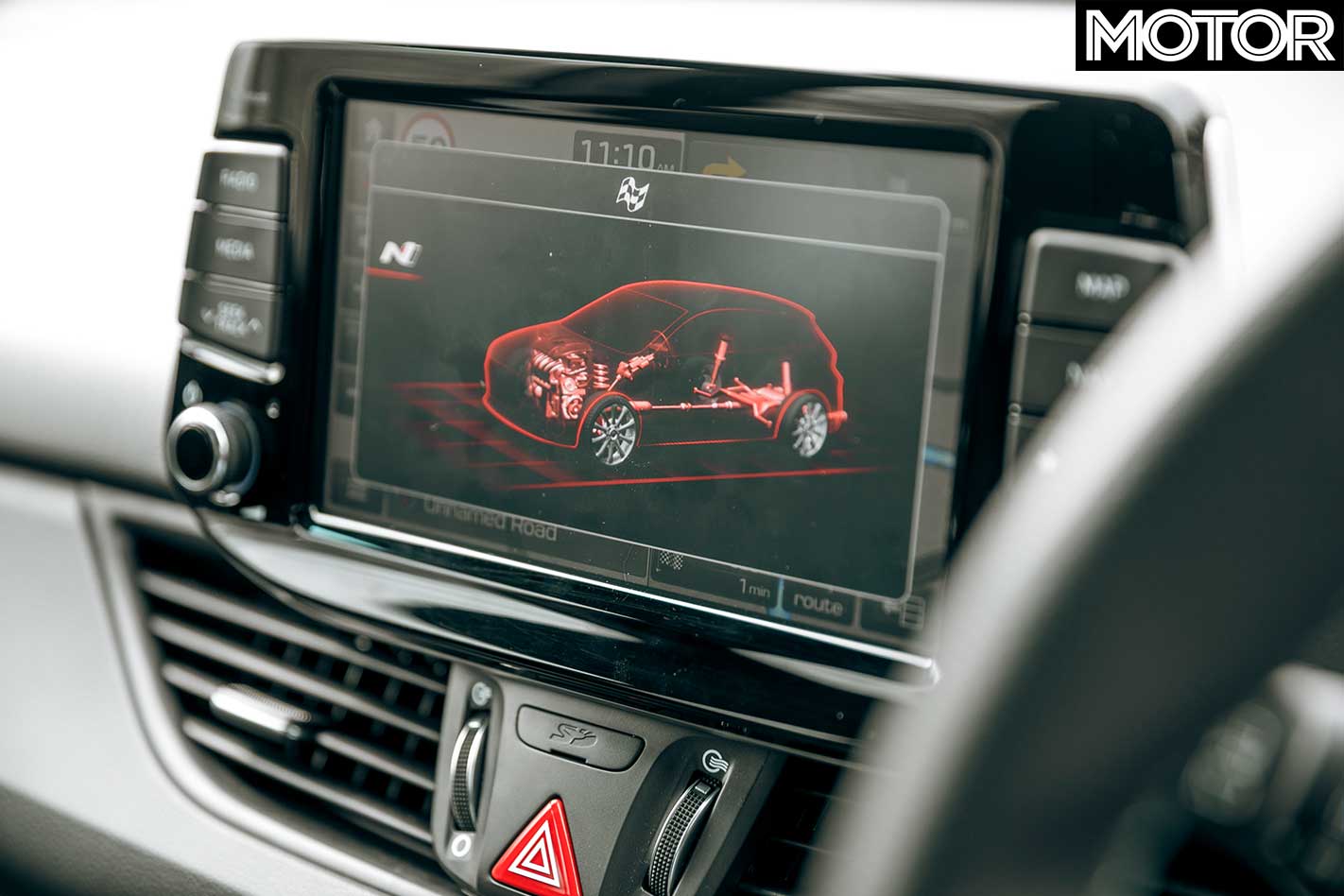
As a quick aside: what does the i30 N have in common with the Porsche Carrera GT? An anti-stall function. Having been taken to task by Hyundai’s PR boss for my complaint about the ease with which it’s possible to stall the i30 N – which is more a function of my lazy driving than any fault of the car – I investigated the anti-stall system, which is separate from the rev-matching function. This brings me back to the Carrera GT.
Upon its release, Porsche’s mega-buck hypercar was criticised for the savagery of its tiny carbon-ceramic clutch. Whether Porsche forgot to mention it or, more likely, journos forgot to listen, the Carrera GT had an in-built anti-stall function that allowed for smooth take-offs as long as you didn’t touch the throttle, which confused the system and allowed the engine to die.
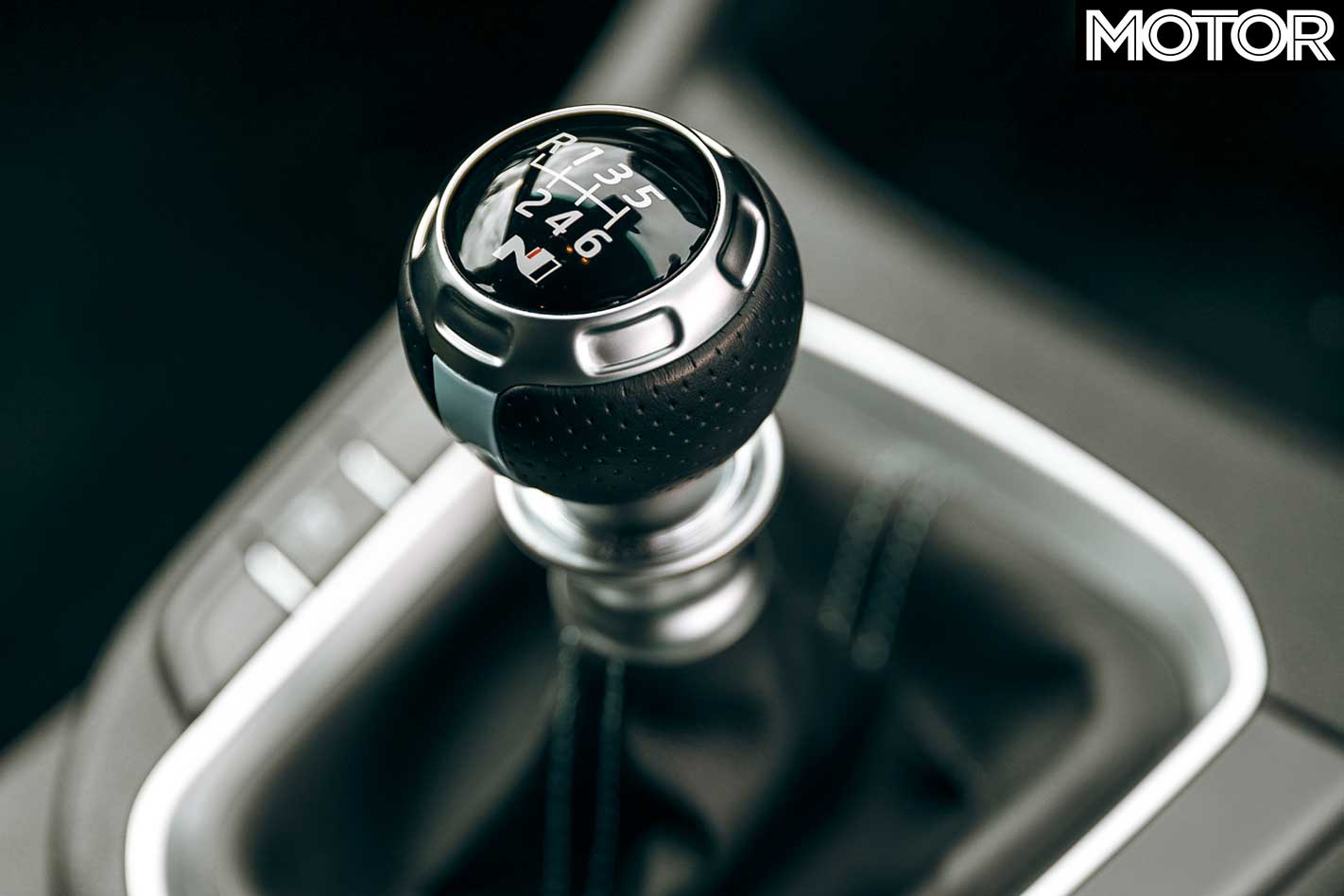
Now, anti-stall or not, I’m not suggesting the i30 N is anything like as capricious as the Carrera GT, but I think the systems operate in a similar fashion. Let the clutch out slowly with no throttle and the i30 N smoothly moves from a standstill; apply a little bit of throttle and the computer thinks you’re taking things into your own hands – or, in this case, feet – backs off the assistance and if you’re sloppy with your inputs, lets the engine die. Regardless, stalling has become much less common in recent times.
When it’s time to use the i30 N as its maker intended there are two options. Either cycle through the drive modes using the button below the left-hand spoke of the steering wheel, which shifts all respective components to Eco, Normal or Sport.
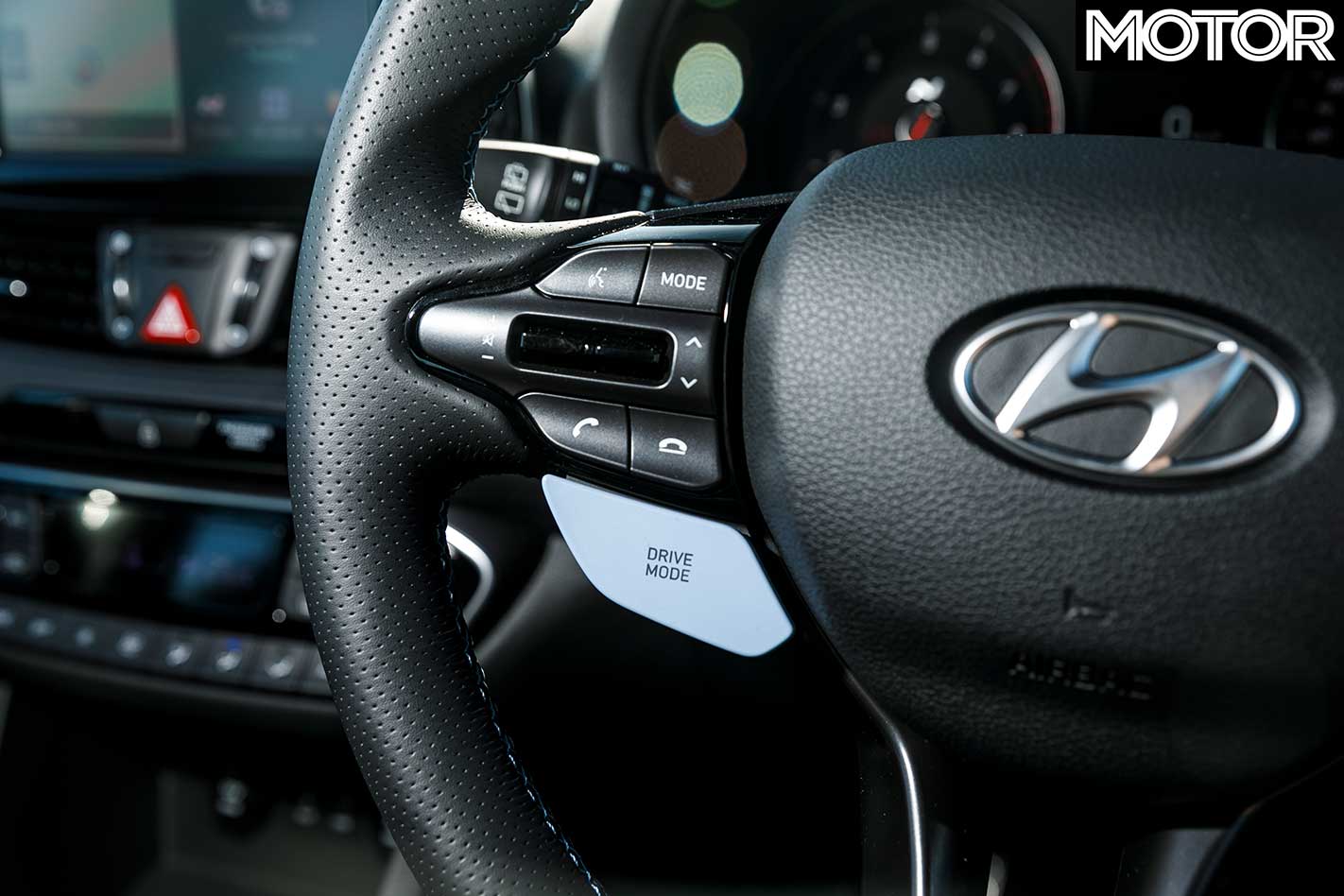
The second option is the chequered flag button on the other side of the horn. One press activates the maximum attack N Mode, but a second press allows you to individually select your favoured combination of settings in an N Custom mode.
Of course, anyone who has driven a BMW M model in the past decade will be familiar with the M button, expanded with the latest generation of cars with an ‘M1’ and M2’ button, allowing the driver to save two setting combinations.
In the Hyundai, the various settings are selected via the central touchscreen with the menus split into Powertrain and Chassis. For reference, my N Custom selections are maximum sportiness for every Powertrain setting, while on the chassis side it’s Normal steering, ESC in Sport and suspension in either Normal or Sport depending on the demands of the road.
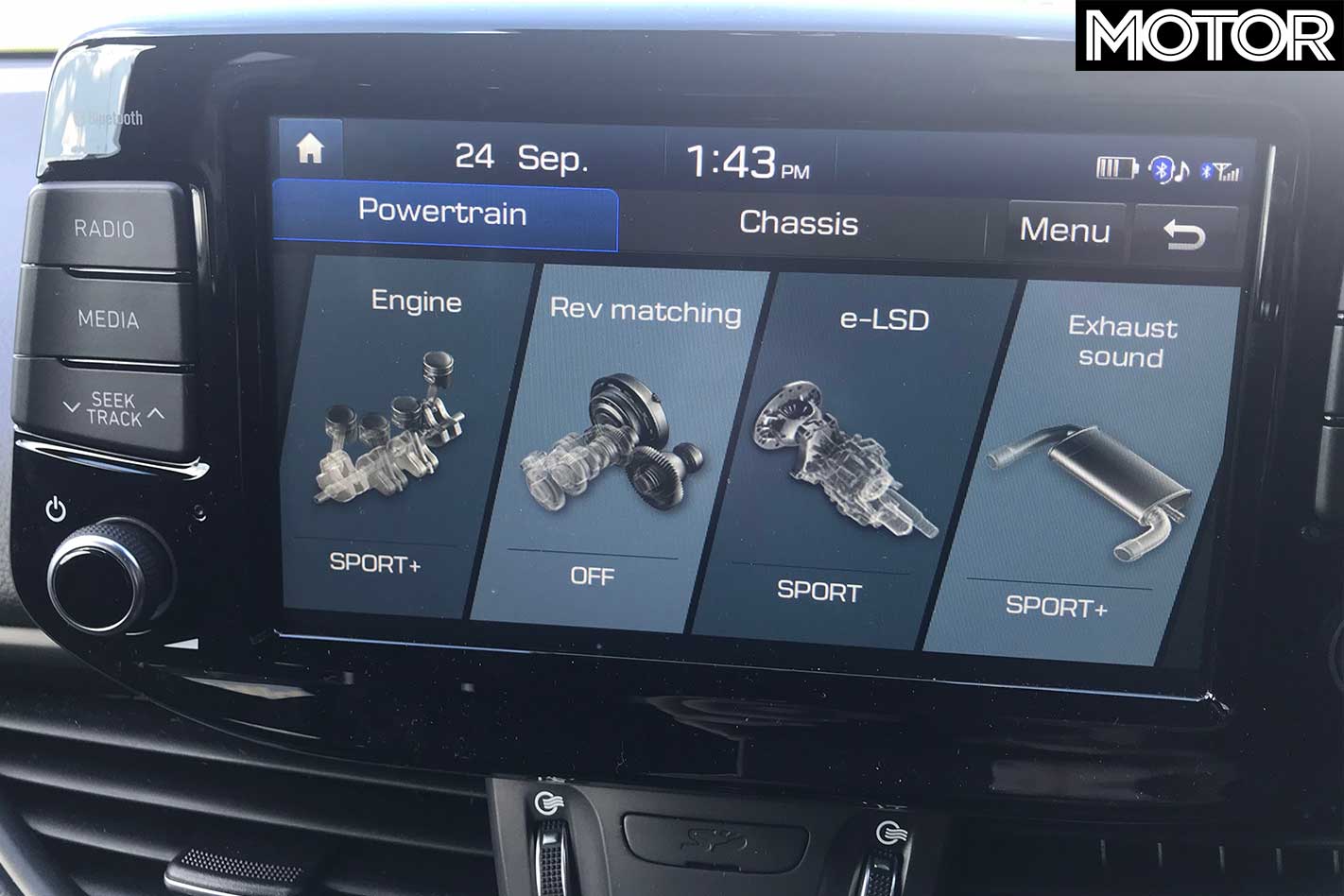
Returning to the conversation with that M engineer, I suppose that’s the advantage of these myriad settings – choice. For mine the exception is steering; I can’t imagine a scenario in which you’d want heavier steering than the Normal weighting – why increase the driving effort?
Next month, we engage N Custom mode and test the i30’s abilities at the racetrack.

2018 Hyundai i30 N Pros & Cons
Three things that we’re falling for: 1 – Useability 2 – Not stalling 3 – Turns heads
Three things that we’re sick of: 1 – Blue buttons 2 – Quite thirsty 3 – Not much else
Update 4: Hillclimb hottie
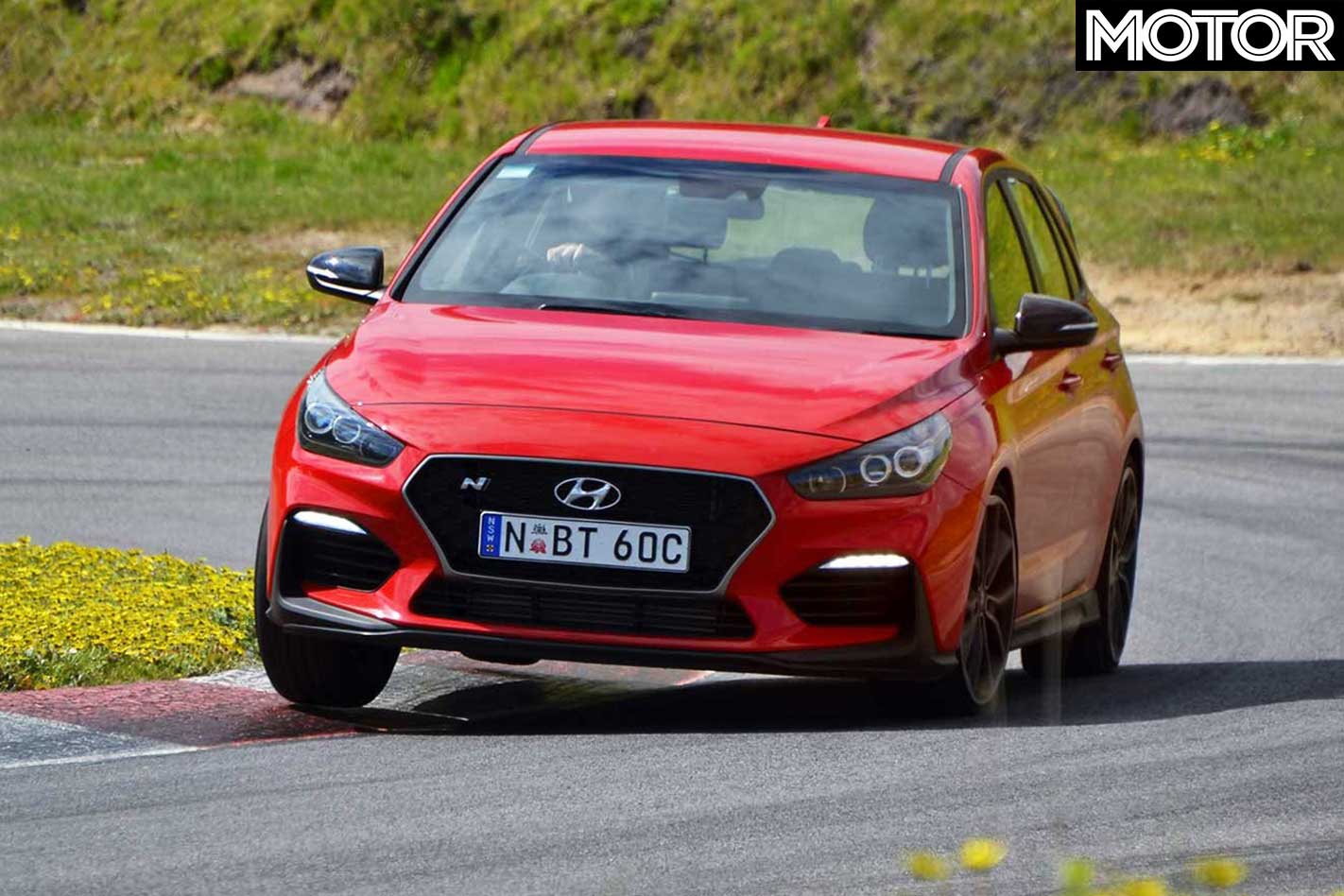
Track days are fantastic fun, but they can be a bit hard on the gear. Very, very few standard production cars can withstand a full day at the track without needing a new set of tyres, brakes or both, not to mention the heavy fuel consumption.
Thankfully, there are myriad other ways to get a competitive fix that are easier on both your car and wallet. These include autocrosses, motorkhanas and this month’s topic, hillclimbs.
Generally slow speed and short in duration, brake and tyre wear are minimal and temperatures are always under control. The annual Kyneton Car Club hillclimb at Bryant Park – more commonly known as Haunted Hills – in Victoria’s Gippsland region is the perfect example. For the grand total of $100 each competitor receives eight runs of around 60-70sec split evenly across two different track layouts.
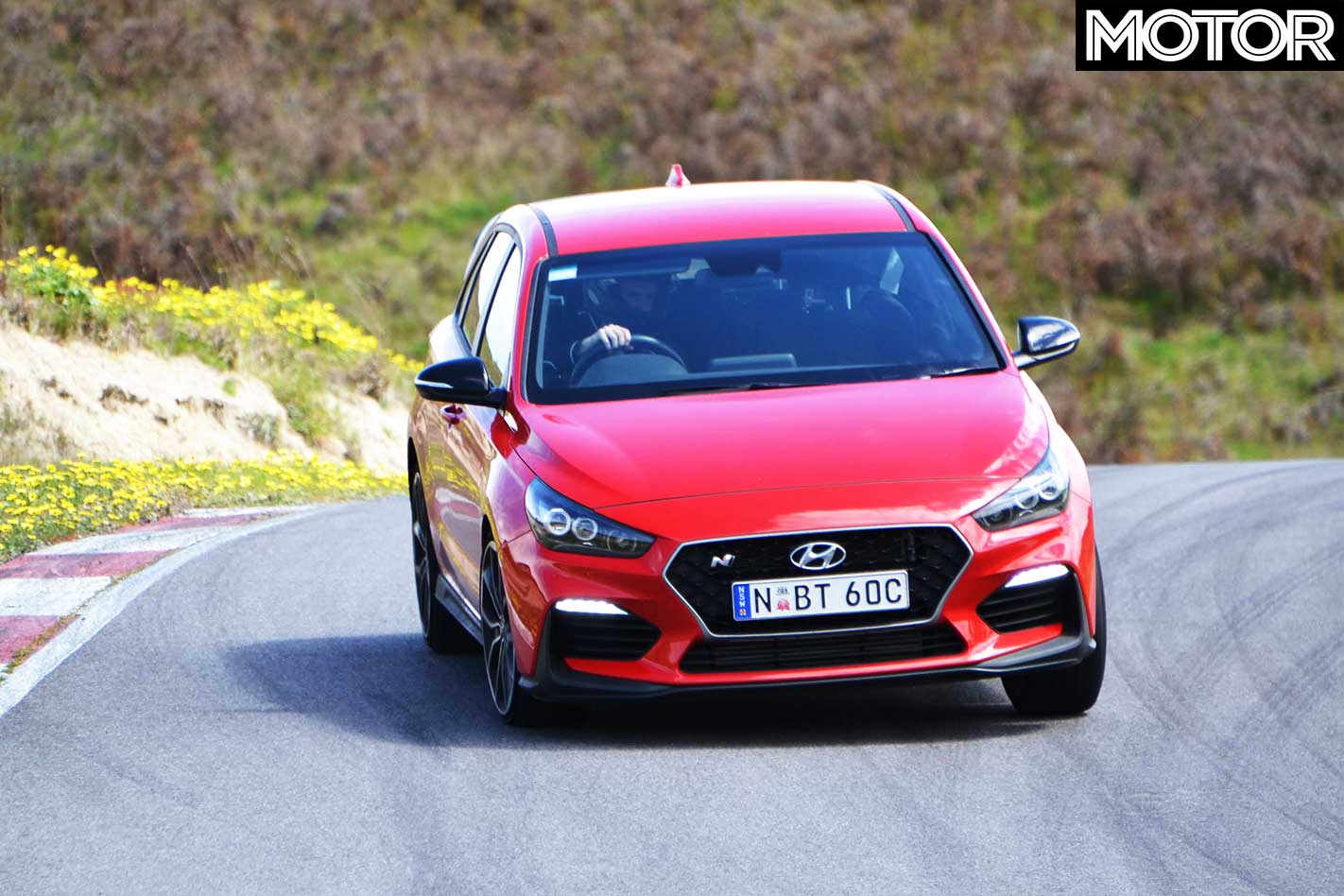
The low level of mechanical stress is evident in the incredible variety of cars competing, everything from well-worn Subaru WRXs on semi-slicks to a Holden VE Calais family hauler to various Japanese and European 1980s rear-drivers. And a showroom-fresh Hyundai i30 N.
A helmet and an internally mounted fire extinguisher are the only safety requirements and if entering a brand-new car in a competitive event seems risky, consider that unlike a track day, where there are other cars and drivers to worry about, at a hillclimb the only way damage could occur is if the driver makes a major mistake.
Mistakes, minor ones at least, are hard to avoid in hillclimbs. Kyneton’s format is such that each competitor’s best run on each track layout is combined for their final time, alleviating the pressure of nailing every run.
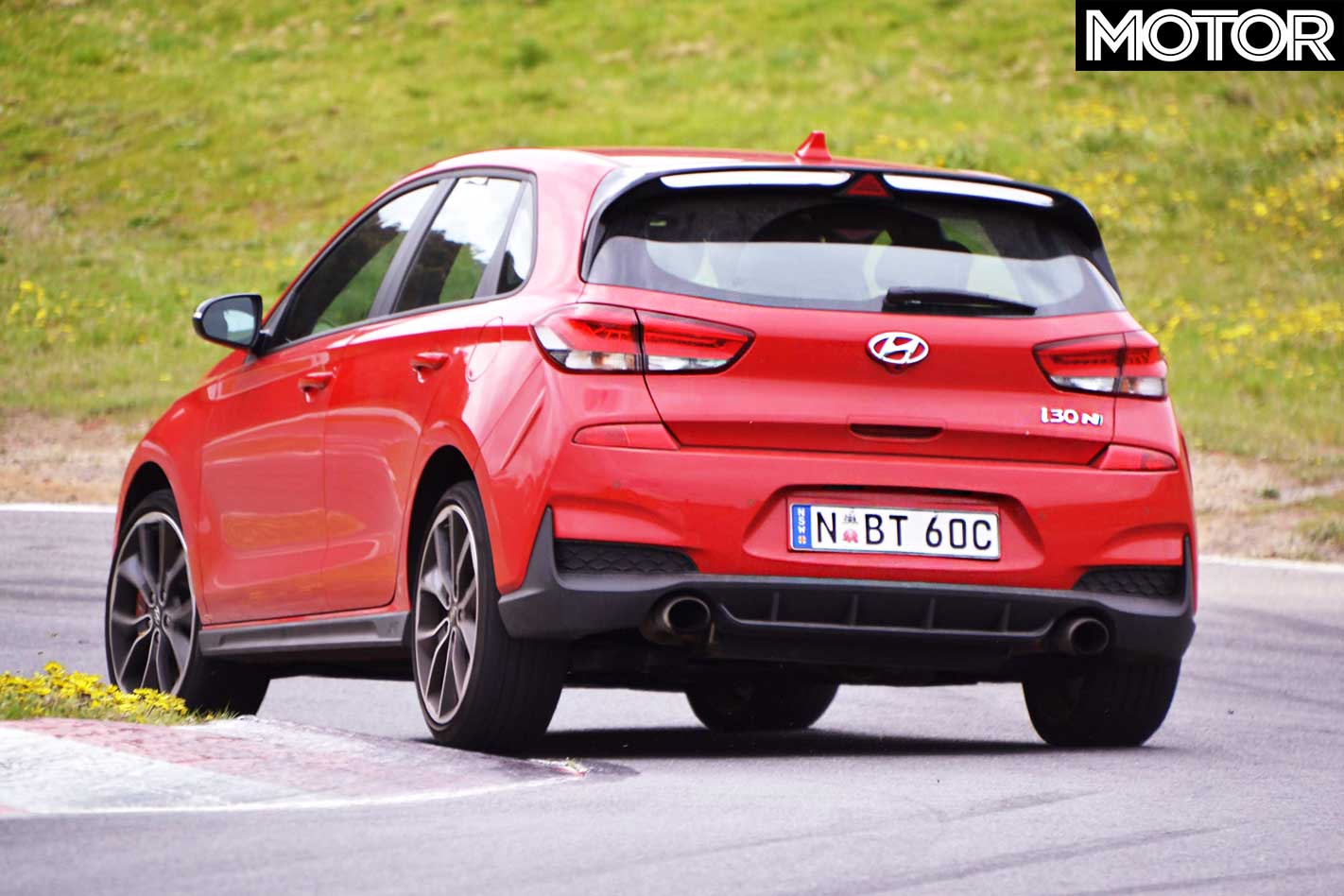
Nevertheless, the need to push hard from the very first metre, usually with cold tyres and brakes, requires focus, especially as the times are often close enough that an overshoot or half-spin will result in tumbling down the order.
MOTOR long-termers have previous form at the Bryant Park Hillclimb; I ran my Peugeot 208 GTi here in 2014 and it finished a credible sixth outright. The track’s tight confines and constant turns favour grip, agility and traction, though a bit of power doesn’t go astray.
With such a diverse array of cars, it’s almost impossible to have expectations, but I was hopeful the i30 N’s turbo torque, electronically controlled LSD, strong brakes and outright grip would allow it to be at least competitive.

Two slow sighting laps are allowed in convoy to understand the track layout, but the first competitive run is still conservative, with braking points and outright grip levels still unknown. Still, its 66.61sec opening salvo is quickest by 1.21sec, raising a few eyebrows.
The nearest competition is Ian Johnston’s home-built Toyota Lexcen, which doesn’t sound too impressive until you discover it has a 6.6-litre supercharged V8 producing well over 500kW, a custom all-wheel drive system, independent rear end, ABS, traction control – the works. It’s a monster, but Bryant Park brings to mind Nelson Piquet’s quote about driving an F1 car at Monaco being like “riding a bicycle in your living room”.
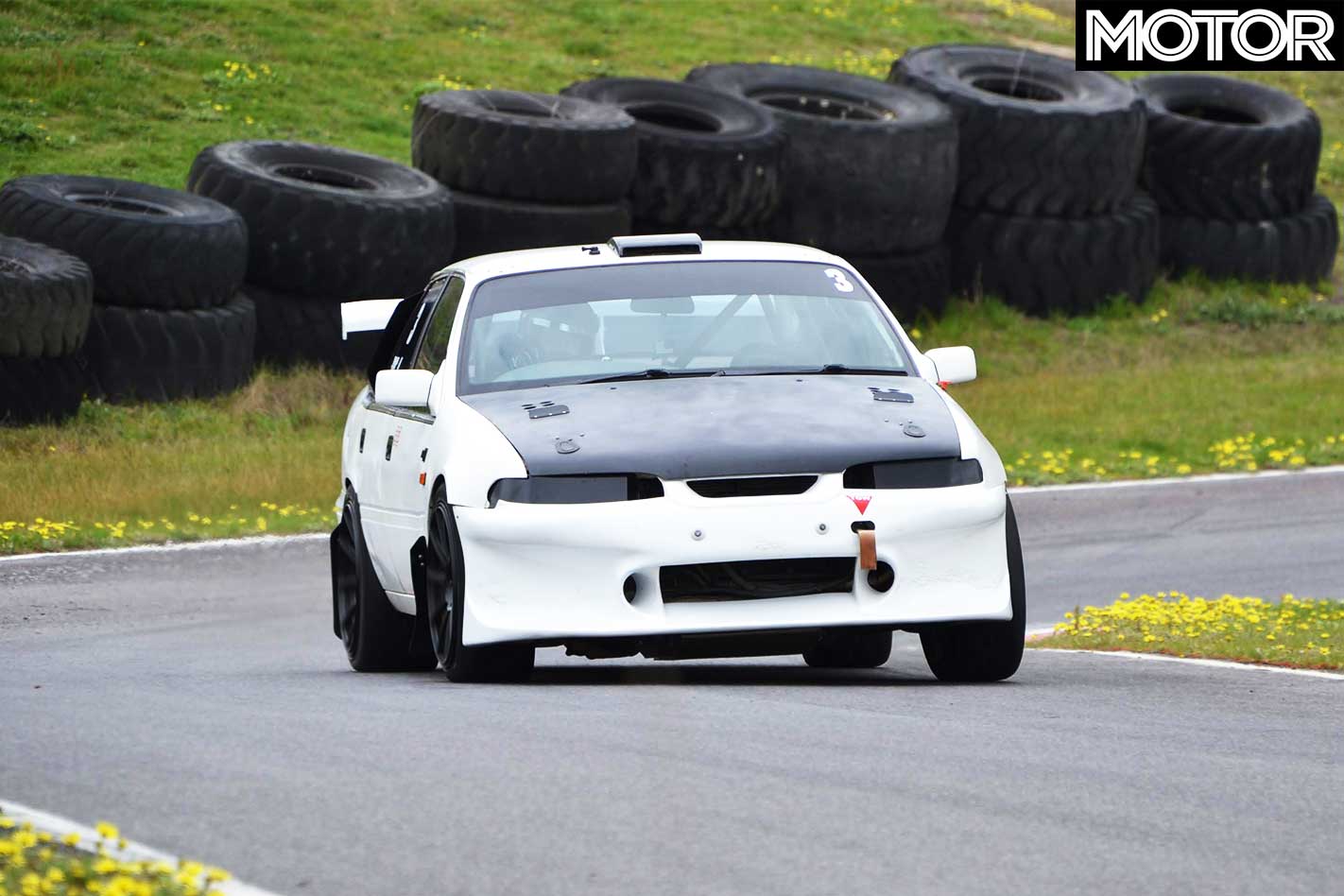
The i30 improves to 65.05sec on the second run, but Ian closes the gap to 0.54sec – too close for comfort. Thankfully, a little extra commitment results in a 63.67sec to secure the quickest time. Onlookers are shocked at the speed of this humble Hyundai, but they underestimate the capabilities of modern performance cars and the pace of their development. The i30 N’s effort is 3.7sec quicker than the 208 GTi – itself a reasonably potent little hot hatch – managed four years ago in almost identical conditions.
On the second track layout that gap widens to four seconds. By now, the Nissan R33 GTS-t of Matt Beardall has joined the fight at the front. Unfortunately, the i30 N is relegated to third on this track layout, but it’s incredibly close, just 0.25sec separating the best runs of a stock front-drive four-cylinder hot hatch, modified rear-wheel drive six-pot coupe and wild V8 all-wheel drive sedan, the common thread being drivers doing their best to squeeze the maximum out of themselves and their machines.
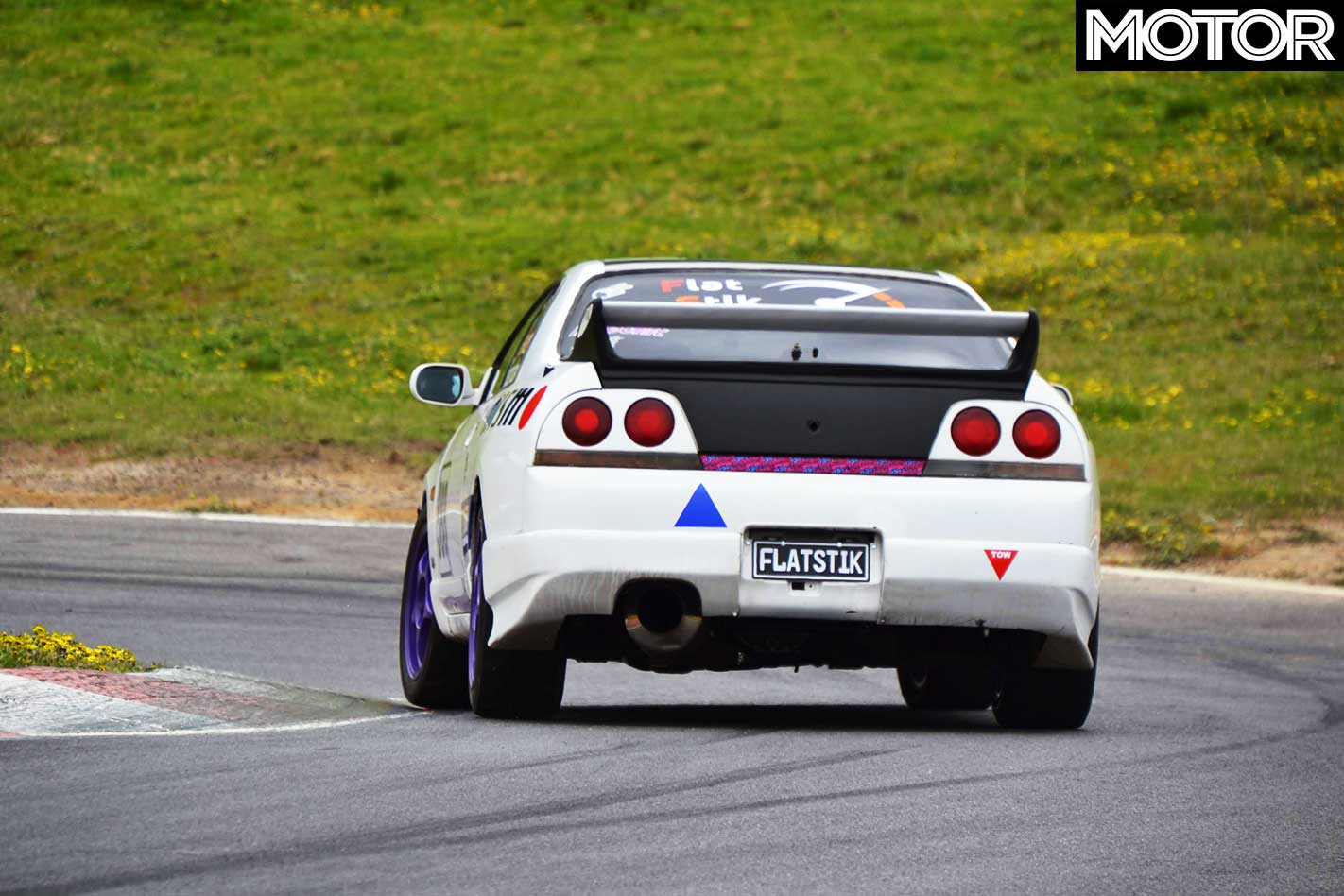
In the final results, the i30 secures victory, its combined time – the best run from each track layout – edging Beardall by just 0.96sec. The true hero of the day was the Hyundai’s ESP system. On cold tyres, the i30 N wasn’t afraid to wag its tail on Bryant Park’s initial fast downhill run; set to Sport the ESP provided enough leeway to prevent time loss while straightening the ship on a couple of occasions when the driver’s ambition outweighed his ability.
Without that safety net, I simply wouldn’t have had the confidence to push as hard. Speaking of pushing hard, next month it’s time for some track work.
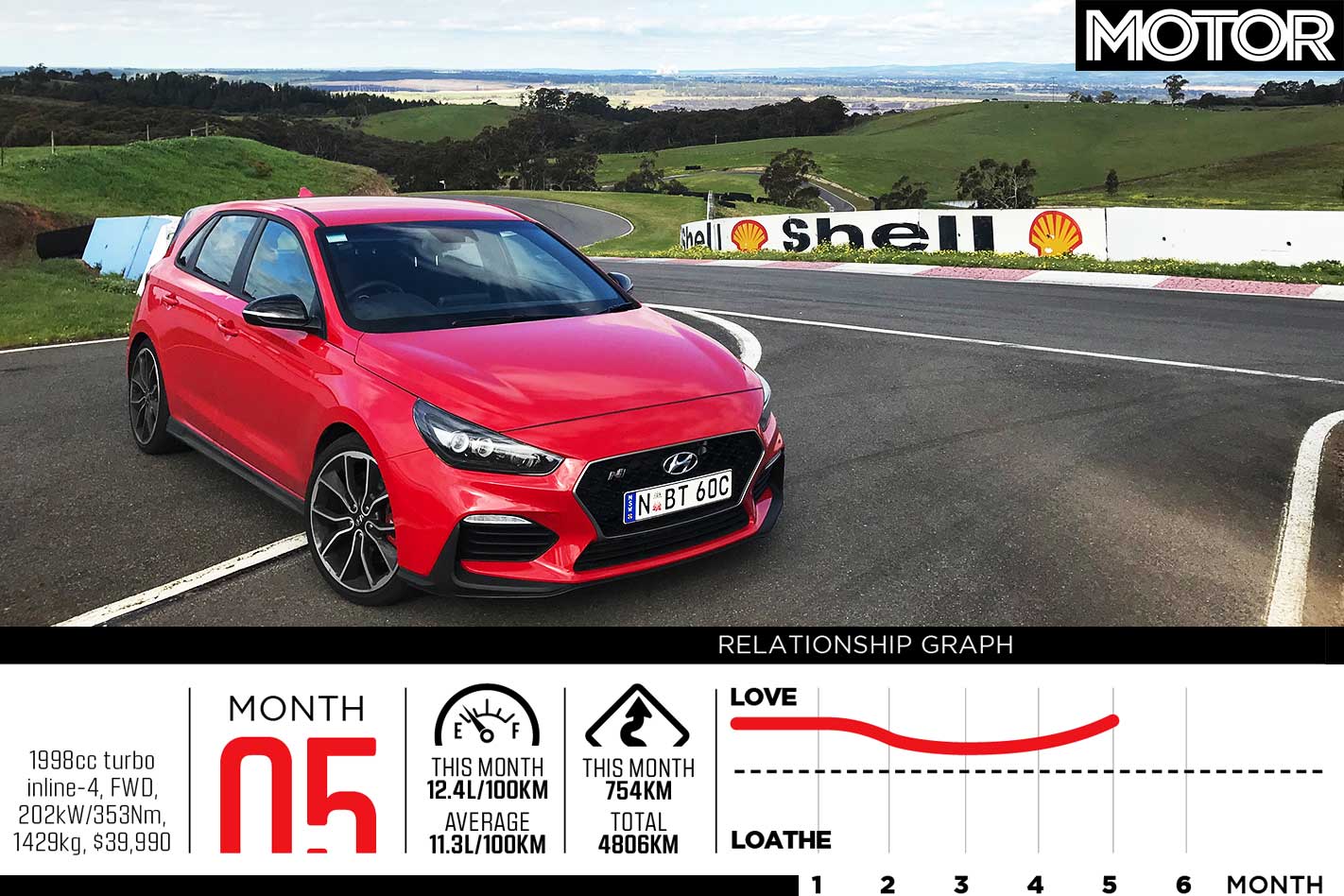
2018 Hyundai i30 N Pros & Cons
Three things that we’re falling for: 1 – Winning 2 – Sports ESP 3 – Driving home
Three things that we’re not fond of: 1 – Being beaten 2 – Power understeer 3 – Post-racing blues
Update 5: Track star
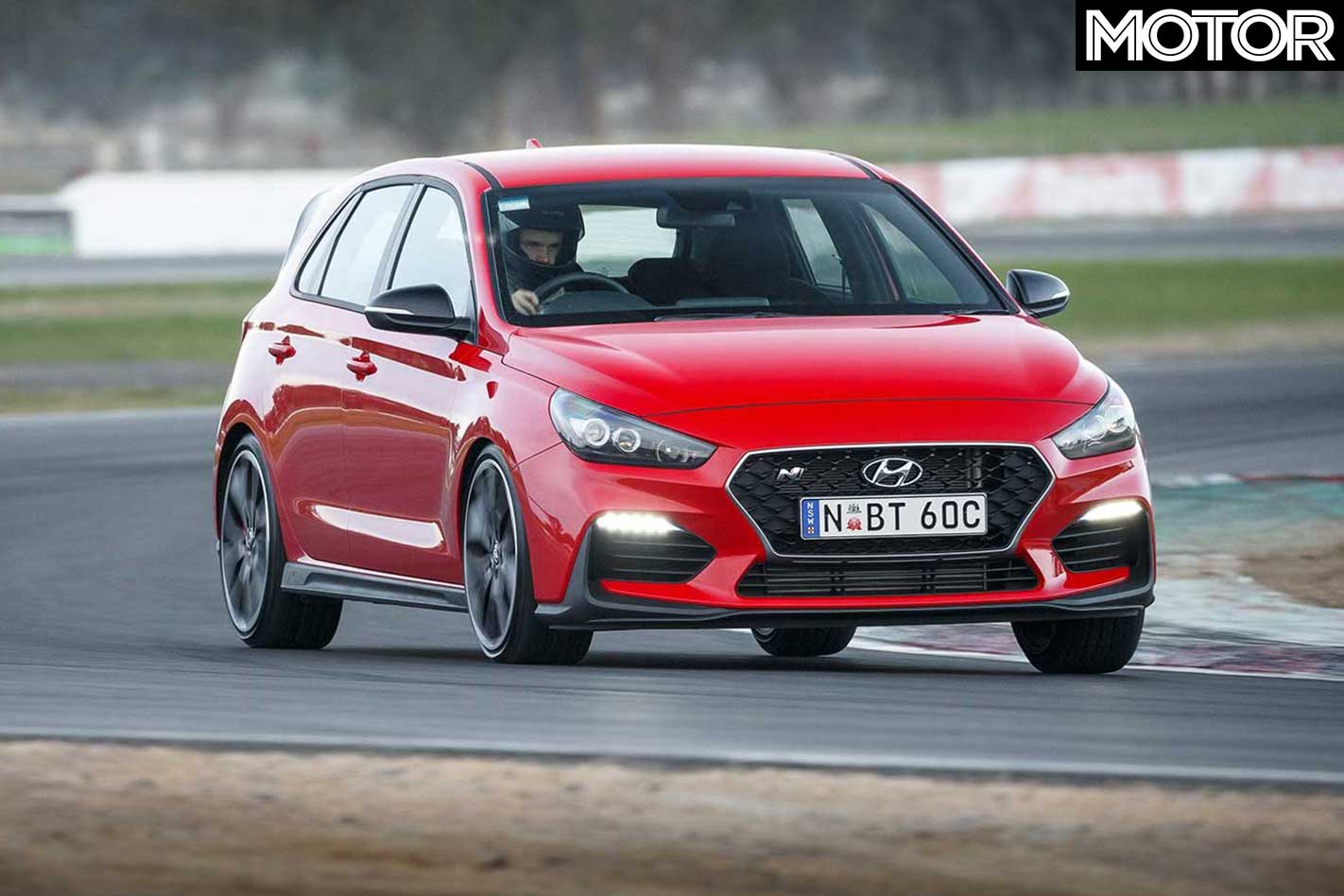
There’s been a lot of chat about warranties in the automotive media recently. Not the sexiest topic, but a very important one for peace of mind when buying a new car.
So far in 2018, Holden, Ford, Mazda, Citroen and Peugeot have joined Skoda, Honda and Hyundai in offering a five-year, unlimited-kilometre warranty, though Tesla (eight years/unlimited km) leads the way, with Kia (seven years/unlimited km) and MG (six years/unlimited km) securing the silver and bronze medals respectively.
Hyundai caused a further stir with the release of the i30 N by announcing it would extend its warranty to cover track use. Such a stance isn’t unprecedented: like Hyundai, a number of manufacturers offer track coverage on certain models, though no one else has been as keen to publicise it.

The warranty covers “non-competitive” use, so your weekend track day is fine, the hillclimb we competed in last month is not. However, this only applies to components directly affected by that use. Had I broken first gear on the start line of that hillclimb, tough luck, but had the headlights stopped working then that has nothing to do with a competitive environment.
Hyundai goes one step further by covering the use of non-standard rubber. Bolt on a set of R-spec tyres for your track day and despite the higher stresses involved, Hyundai is confident its first hot hatch will take the punishment.
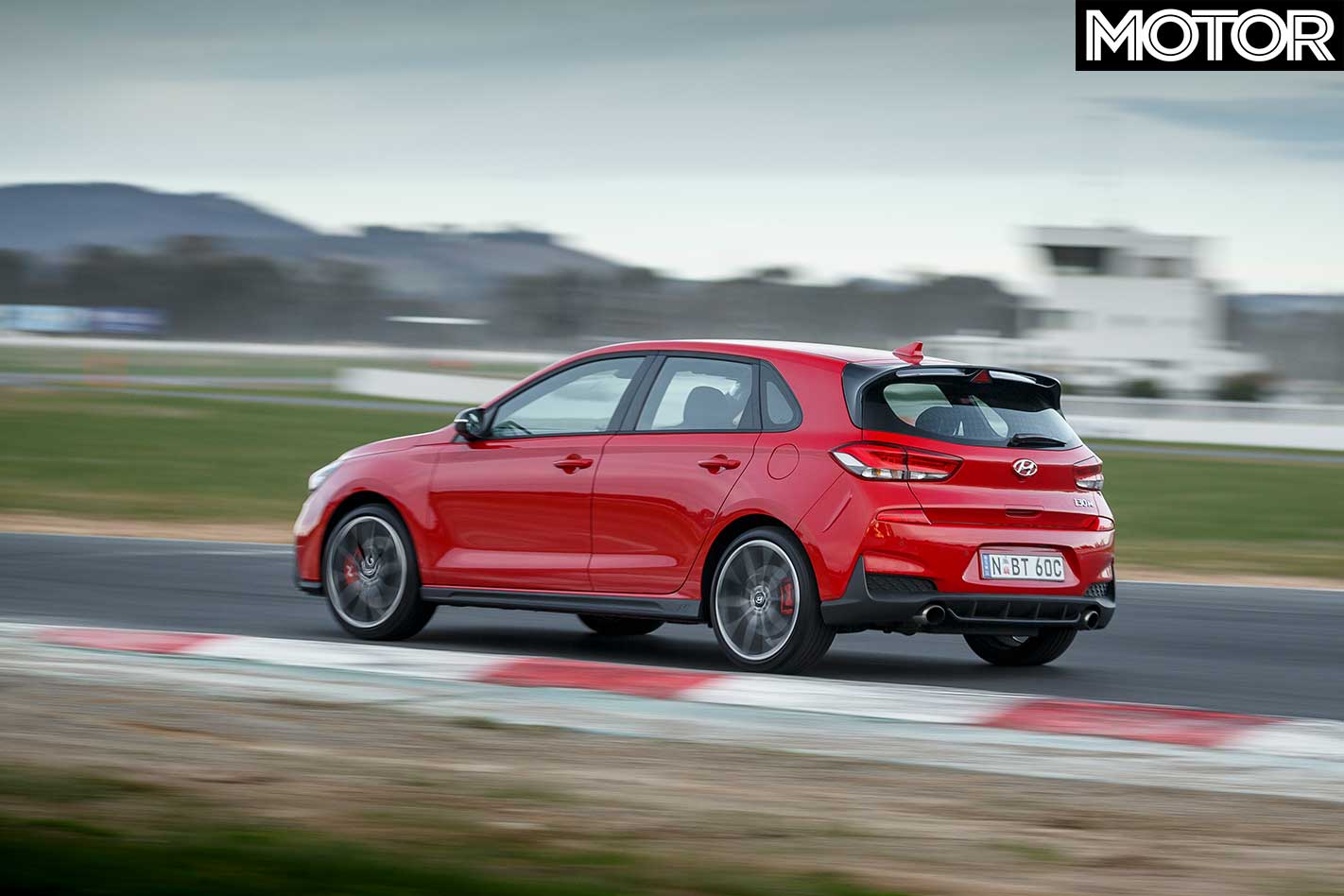
We’ll be doing just that next month, but first let’s examine the i30 N’s circuit prowess in stock form. While ‘my’ i30 N has only seen track action once at Sandown (and technically Haunted Hills) I’ve also driven the standard car at Winton during this year’s Bang For Your Bucks and at The Bend Motorsport Park during recently completed Performance Car of the Year testing, so plenty of laps on different track layouts and surfaces.
Once beyond pit lane you notice the i30’s lack of top-end grunt far more acutely than on the road. As mentioned before, the turbo runs out of puff at higher revs, its size chosen for response and mid-range torque rather than outright grunt.
It’s not at all a bad choice, for it works perfectly on the road and has its advantages on track, too, allowing third to be used out of tight corners to maximise traction without sacrificing acceleration.
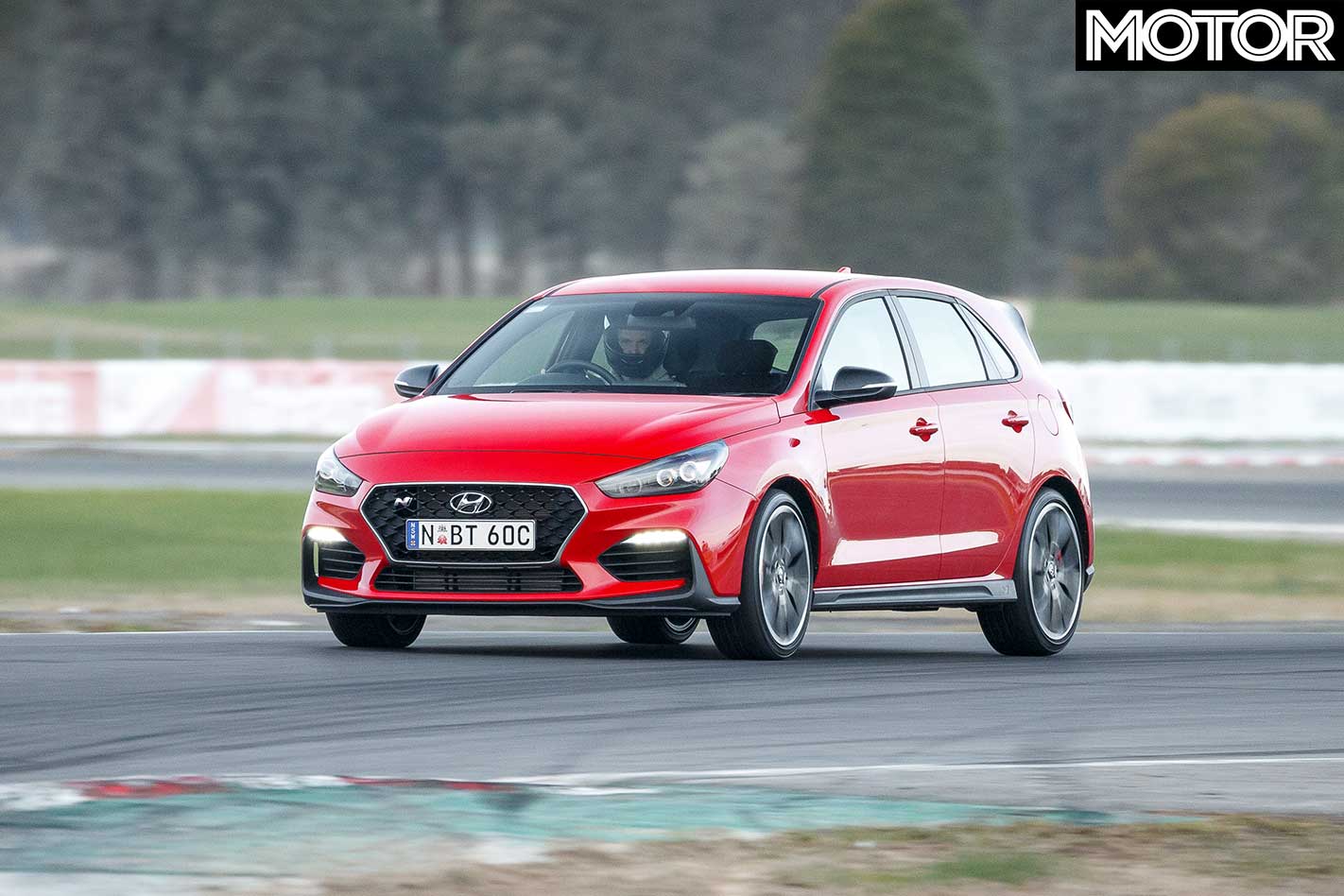
Nonetheless, it’s usually better to pluck the next gear by 6000rpm rather than stretch to the 6500rpm redline or beyond. Oh, and if you are in third, remember to give the throttle a big blip down to second as there’s a large gap between the two ratios.
On cold tyres the i30 is a very keen oversteerer, but the balance quickly improves with temperature. It’s not especially adjustable unless you’re really provoking it, particularly with the firmer damper modes quelling body roll, but don’t confuse the lack of movement as a lack of entertainment. It’s easy to punt quickly and accurately, yet rewards good driving.
Thus far I’ve enjoyed it most on the faster sweepers of The Bend. It was effective at Sandown, but lacks the outright power to make the most of the layout. Winton’s long corners don’t do powerful front-drivers any favours. Those with patience may disagree.
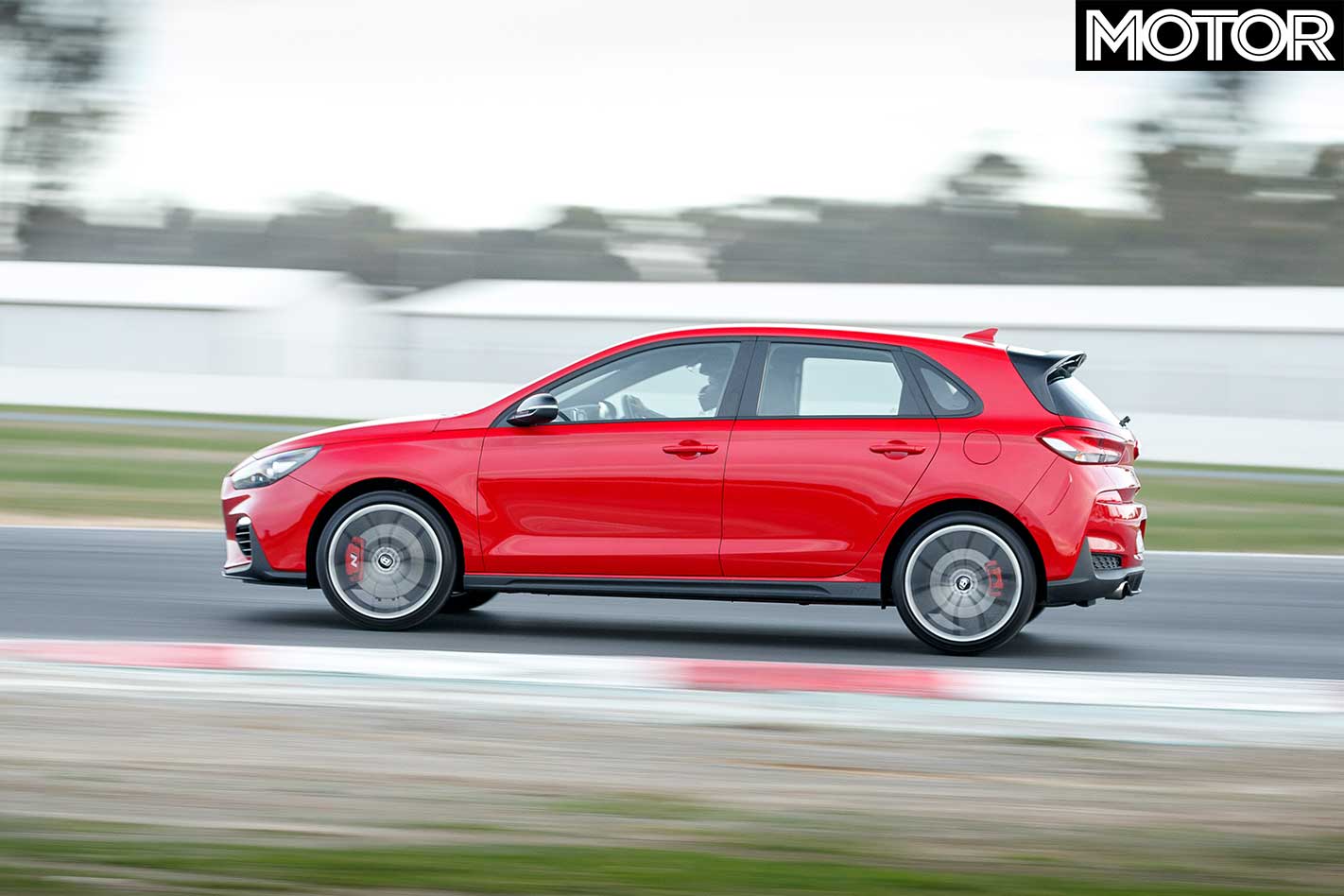
You’d think the obvious suspension setting on track would be Sport Plus, but that’s not necessarily the case. Even at The Bend, which is smoother than a James Bond pickup line, putting the dampers in their stiffest setting had the i30 bouncing, while down Sandown’s bumpy main straight it felt like the wheels were hopping clear off the deck. And that’s before you try and cross the kerbs.
If you’re hitting the track in your i30 N (or any other car for that matter), don’t automatically assume stiffest is best (stop sniggering…).
Hyundai claims to have completed over 100 laps on the same set of tyres at Wakefield Park, but either it has a very gentle test driver or Wakefield is particularly gentle on rubber. Sandown, it seems, is particularly brutal.
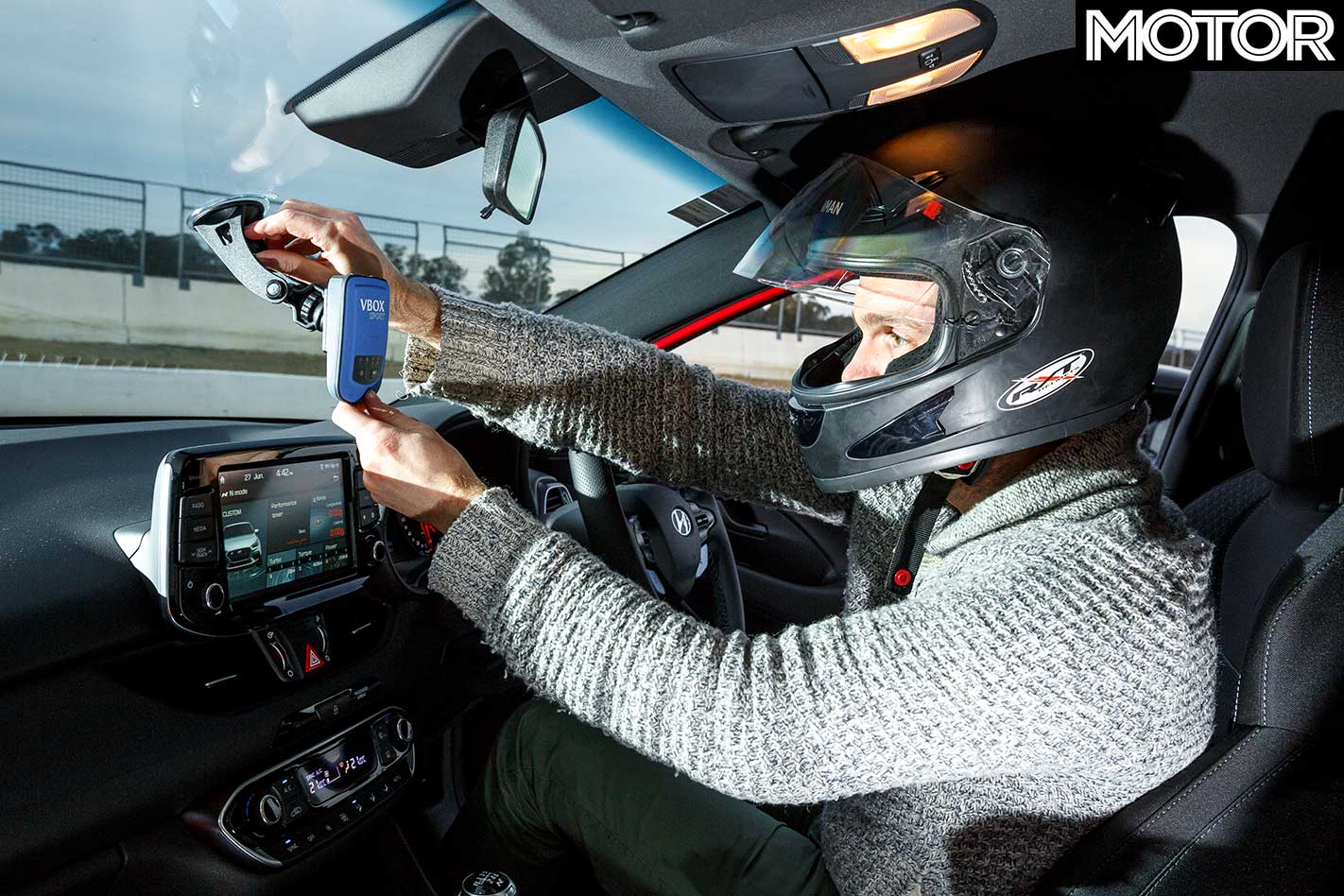
The i30’s bespoke compound Pirelli P Zeros certainly held up better than the Continental SportContact6s on Dylan’s Civic Type R, but two sessions resulted in significant enough wear to necessitate a front-to-back tyre swap, which isn’t the work of a moment with only a standard scissor jack.
At Winton the i30 N displayed a weird vibration at the limit; instead of progressing further into understeer the tyres would begin to gently shudder as they scrubbed across the surface. It displayed the same behaviour at The Bend, which Rick Kelly – someone who knows a hell of a lot more about tyres than I do – suspected was due to a fairly hard tyre compound. This would make sense if Hyundai has asked Pirelli to engineer in some extra track durability.
As mentioned, next month it’s time for some sticky rubber.
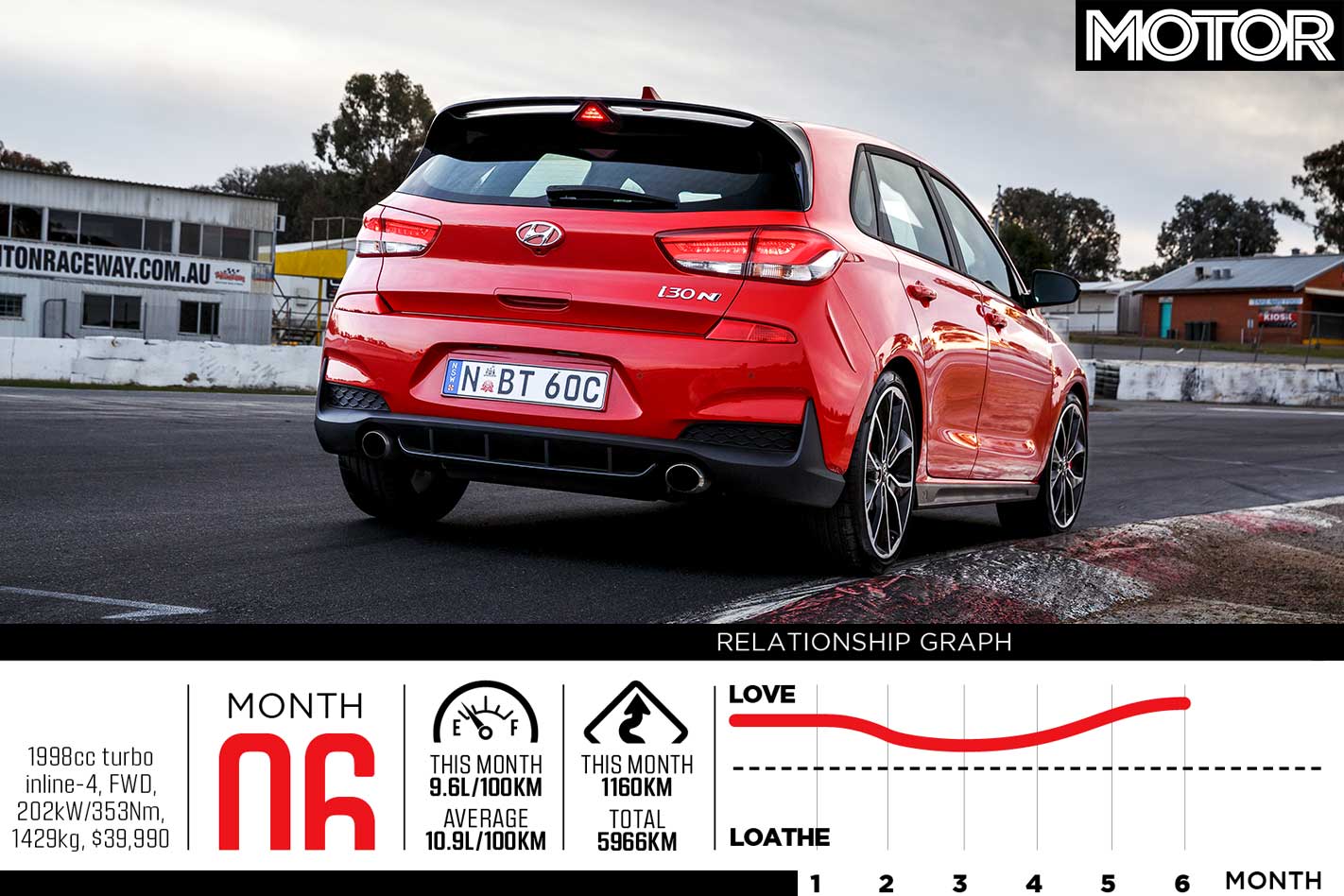
2018 Hyundai i30 N Pros & Cons
Three things that we rate: 1 – Track durability 2 – Front-end grip 3 – Warranty cover
Three things that we hate: 1 – Changing wheels 2 – Tyre vibration 3 – Not much else
Update 6: Rallyin’ time
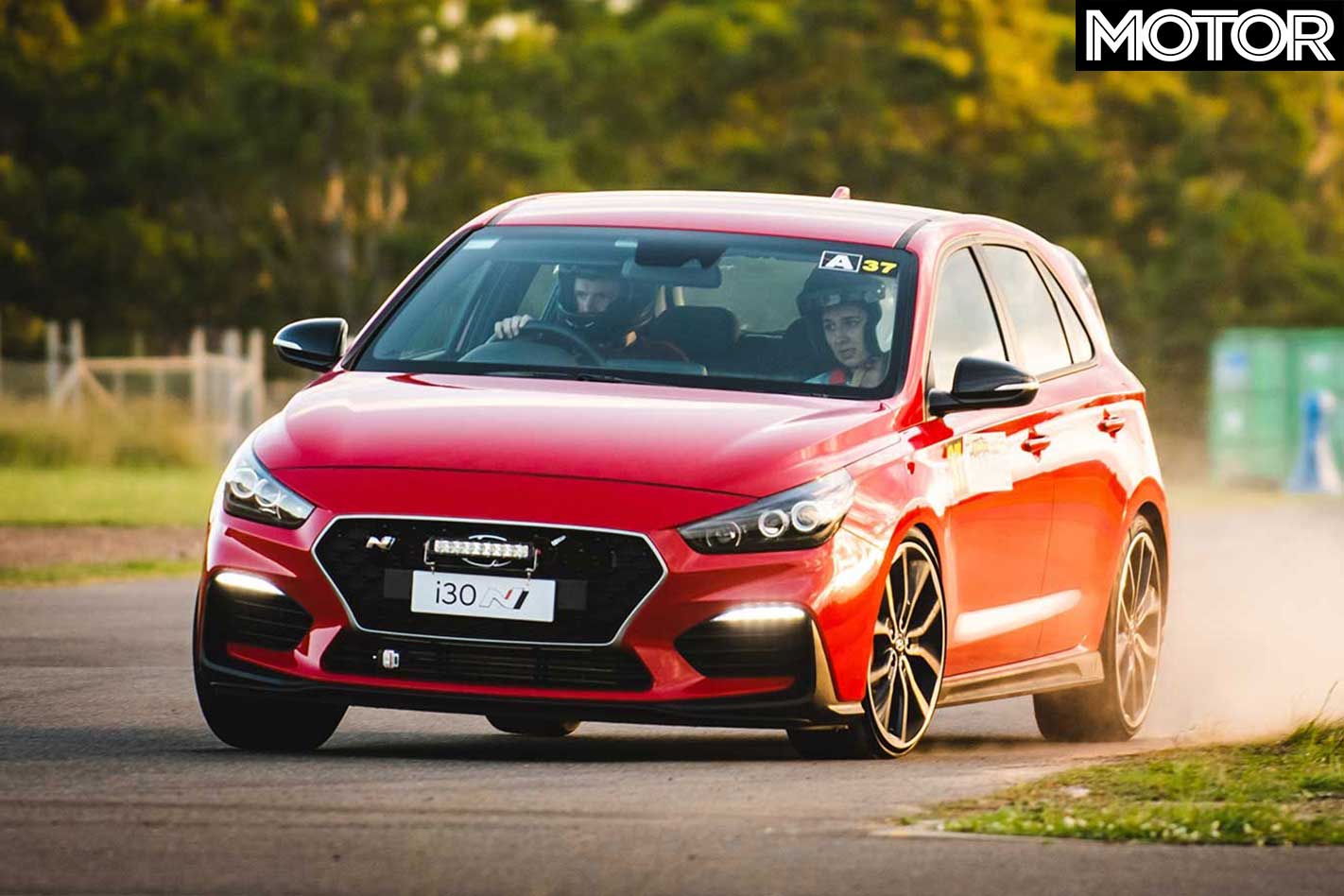
I should be preparing ‘my’ i30 N for competition, but there’s a Toyota Corolla World Rally Car being lowered out of a transporter in front of me and it’s amazing. The Twilight Rallysprint series, held at Western Sydney Dragway by the North Shore Sporting Car Club, may be a fun event, but the entered machinery is very, very serious.
The transporter in question belongs to Neal Bates Motorsport, which unloads the Corolla WRC of technical director Darryl Bush, a modified Toyota 86 for Lewis Bates, and Neal’s restored Toyota Celica ST205 GT-Four Group A, which won Targa Tasmania and the Australian Rally Championship in 1995. I could stare at it for hours.
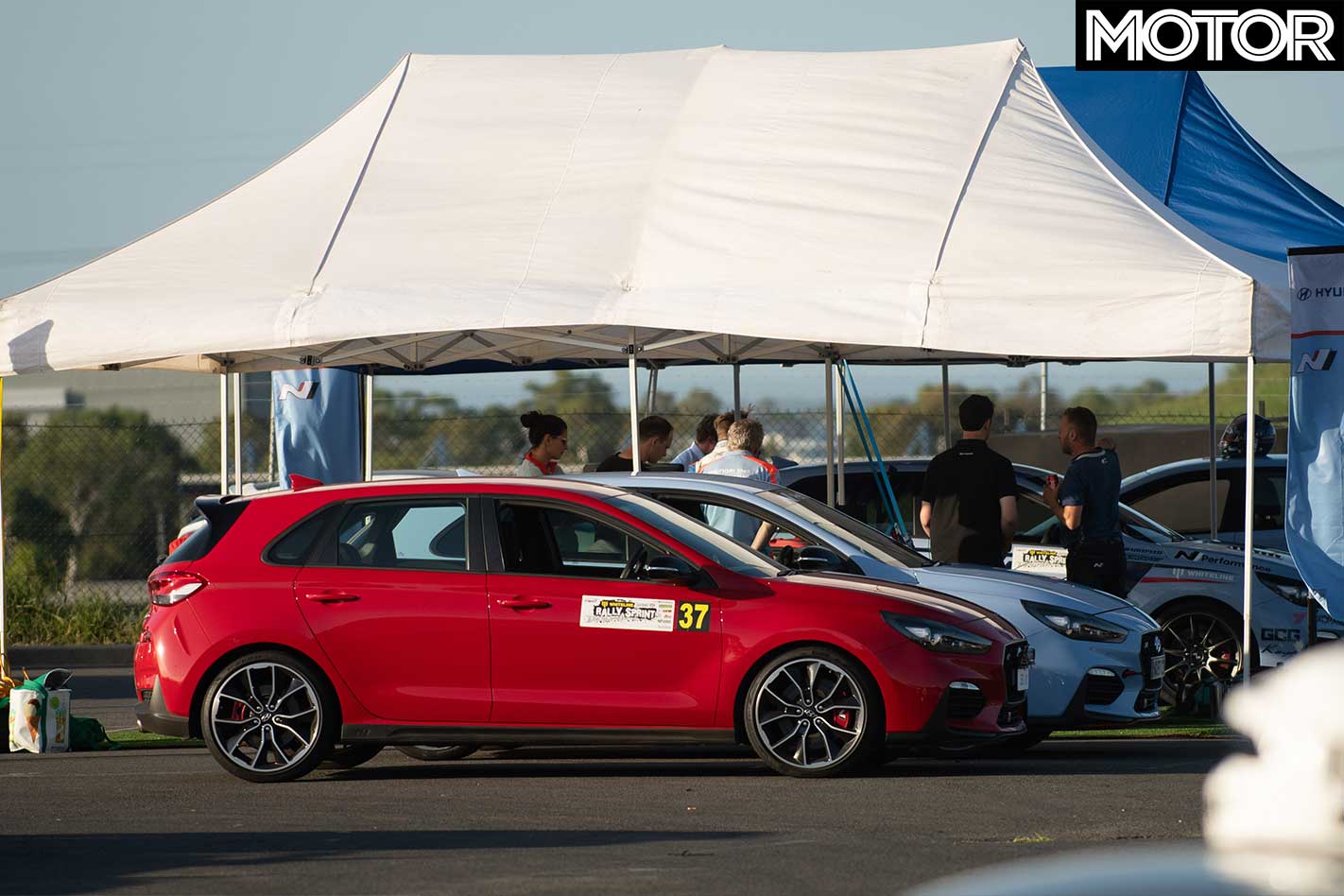
But I don’t have time, because a trio of Hyundai i30 Ns await competition. Hyundai has been a keen supporter of the Twilight Rallysprint and has employed rally royalty of its own. Driving the lead car is Brendan Reeves, while for this round another seat is filled by Wayne Bell.
Bell drove for the Holden Dealer Team in the 1970s and ’80s before piloting Hyundai’s factory F2 car from 1994-1998 in various Asia-Pacific and World Championship rounds. In the third car, there’s me.
The rules of the Twilight Rallysprint are simple: each competitor has five runs, with the fastest three runs counting. Lowest combined time wins. Prior to competition, two slow-speed runs are allowed to check the course and write pace notes. Jumping in the MOTOR silly seat is Brendan’s wife Cass for a bit of intra-marital rivalry.
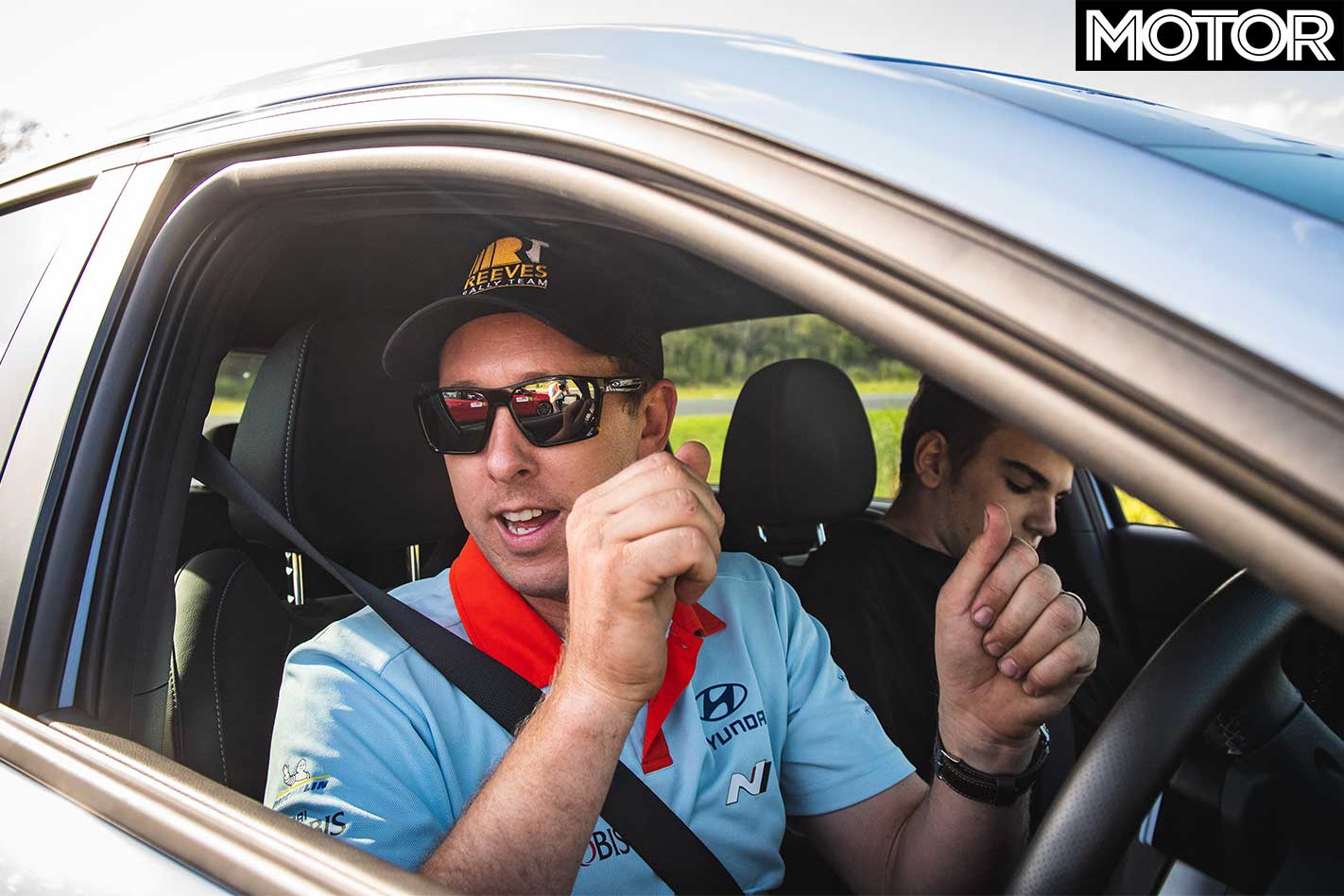
Given what it has to work with, the NSSCC has done a remarkable job of creating an interesting course. It begins with a sequence of 90-degree turns, continues through quicker access roads with a handful of chicanes and a roundabout for good measure before looping around to blast the wrong way up the drag strip, with an ever-tightening chicane the final sting in the tail. The chicanes change every round and the quickest cars complete the course in less than two minutes – even the i30N clocks 160km/h.
Our first three runs are completed on the normal Pirelli P Zero ‘HN’ tyres. The car is standard bar some bitier brake pads that give great pedal feel but are more aggressive; it appears the i30 N now has stopping power beyond the capability of its tyres.
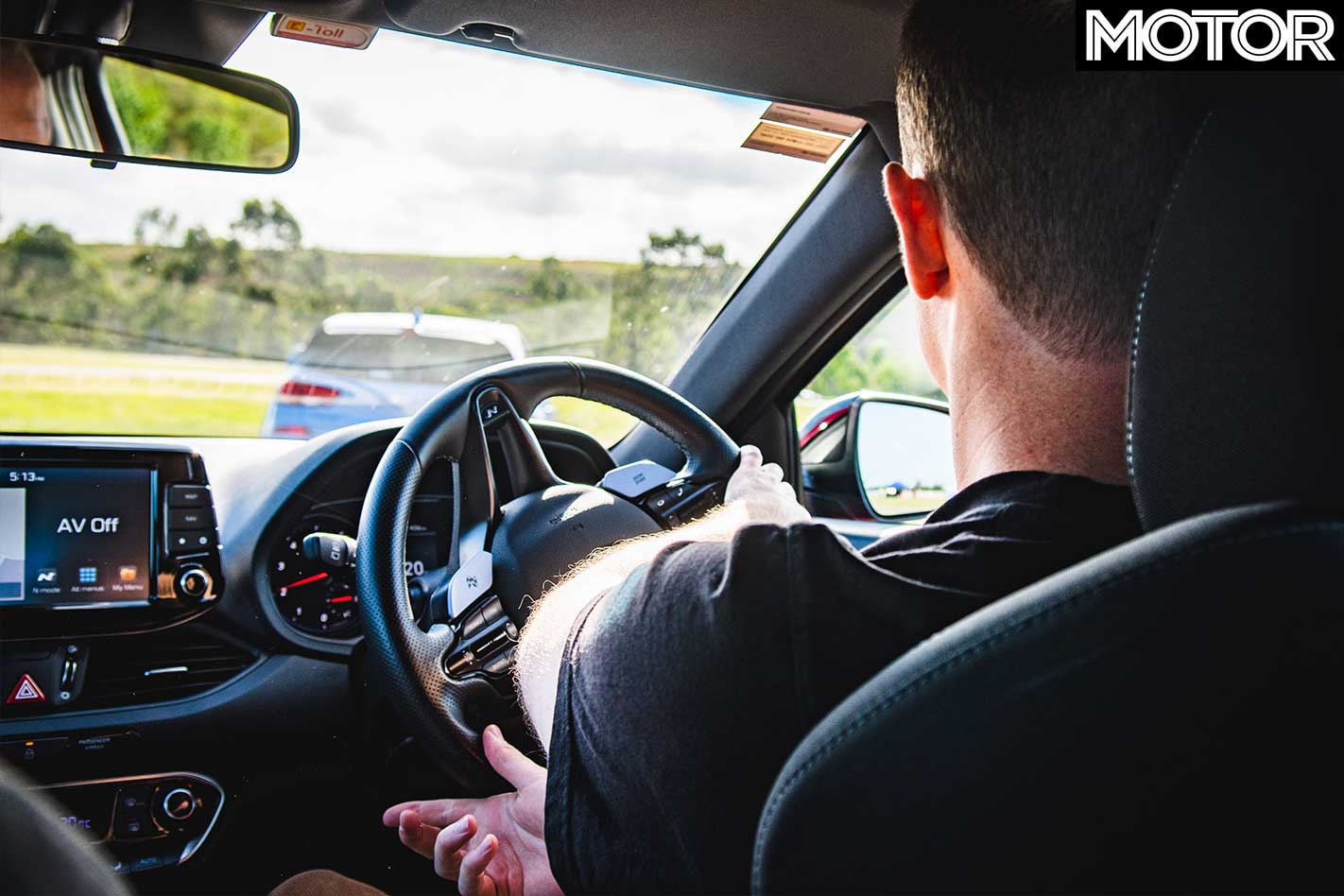
After three runs and an improvement of 2.9sec, it’s time to bring out the big guns: Michelin Pilot Sport Cup 2s. Hyundai is conducting a lot of tyre testing with the aim of offering a ‘track pack’ wheel/tyre combo for circuit-going i30 N owners.
The new rubber doesn’t transform the i30 N, it just makes it a little bit better everywhere. It shows in the times. Even while getting used to the extra grip, our next run is 1.7sec quicker, the final run a second quicker again to record the 17th-fastest time.
The car just feels better; it can be driven more aggressively with a more positive front-end, the inside rear lifting clear of the deck in most turns. The end result is 22nd from 84 entrants, with Brendo securing 17th thanks to his extra power, grip and talent.
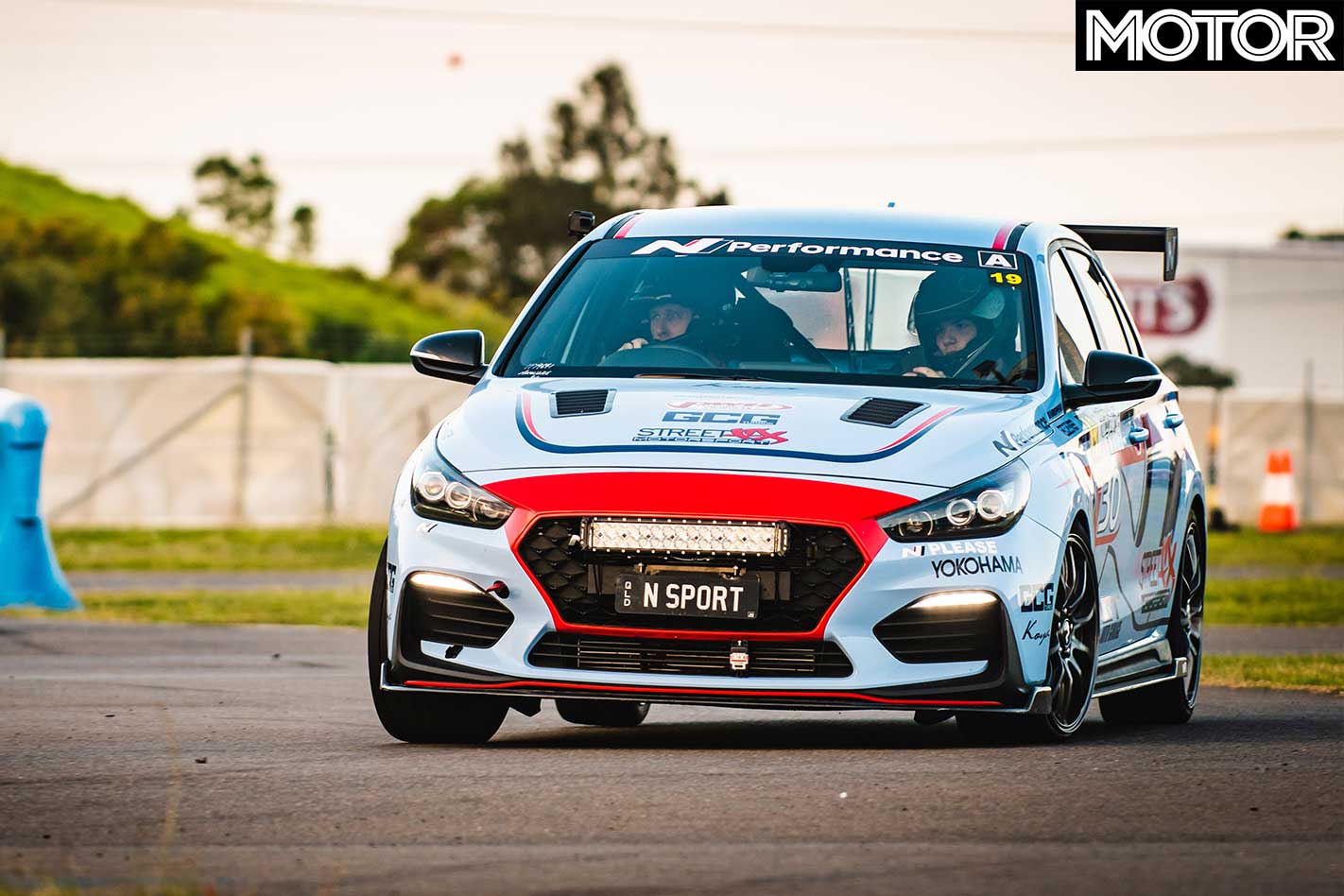
Fast forward a week and we’re at Winton with a set of shiny new Pirelli P Zero Trofeo R tyres, rubber familiar from the HSV GTSR W1. First up, a session on the by-now second-hand standard P Zeros. The track feels a bit greasy, but after a few attempts a lap time of 1:40.7 compares reasonably well to the 1:39.6 Luffy managed during this year’s Bang For Your Bucks.
After bolting the Trofeos on, the first few laps are completed incredibly slowly. The tyres are absolutely brand new and have all the grip of sheet ice.
Once roaded and up to temperature, the i30 N once again feels ace, particularly in change of direction and through Winton’s medium-speed corners. A best time of 1:38.5 shows the value of sticky rubber, but there’s more time in the car.
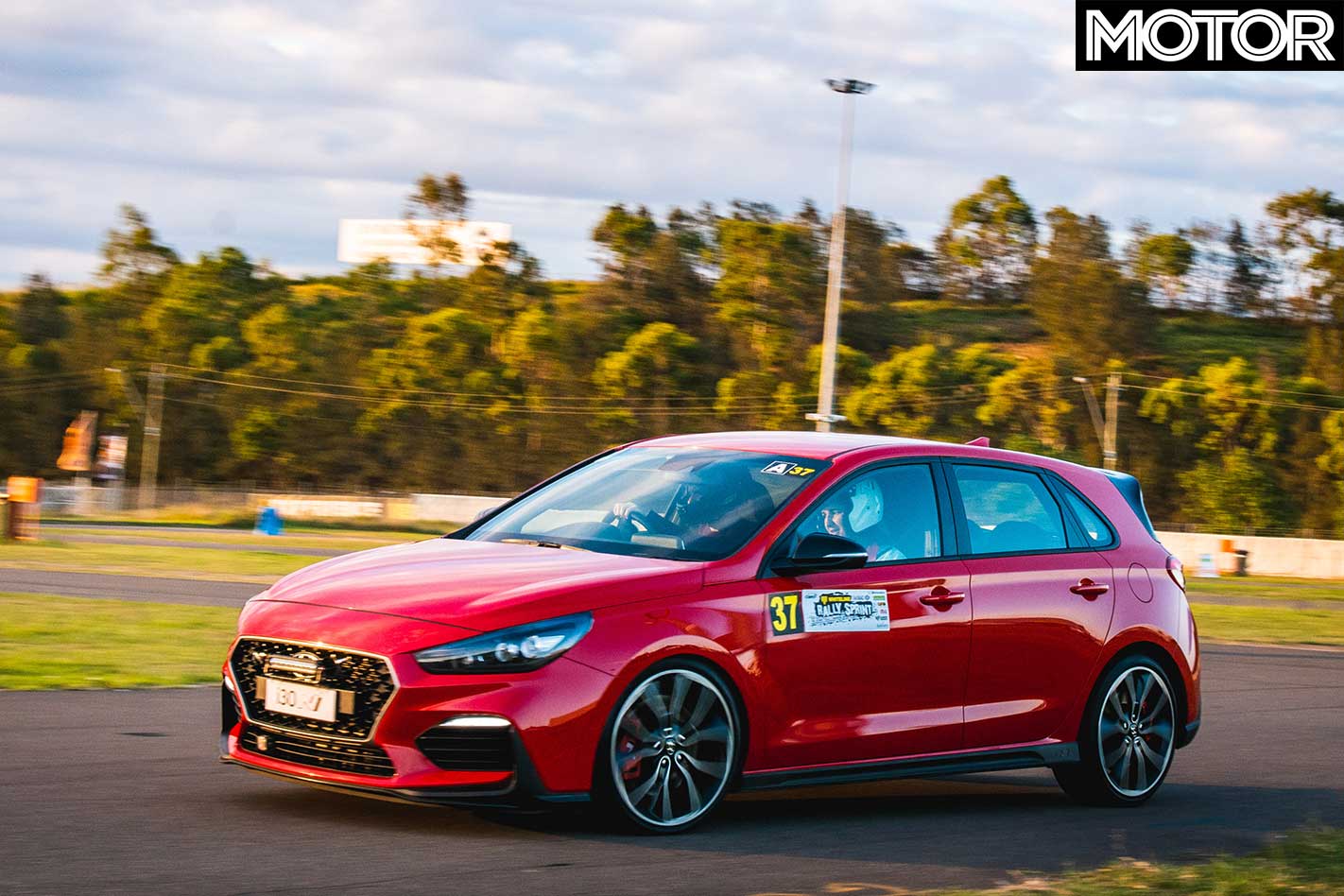
By this stage BT60C’s brakes are feeling the strain, struggling to cope with one lap’s worth of heat, though to their credit they never give up.
So what’s the upshot of all this fun? If you want to track your i30 N, invest in some sticky rubber, some better pads and fluid, and enjoy taking some much more exotic scalps.
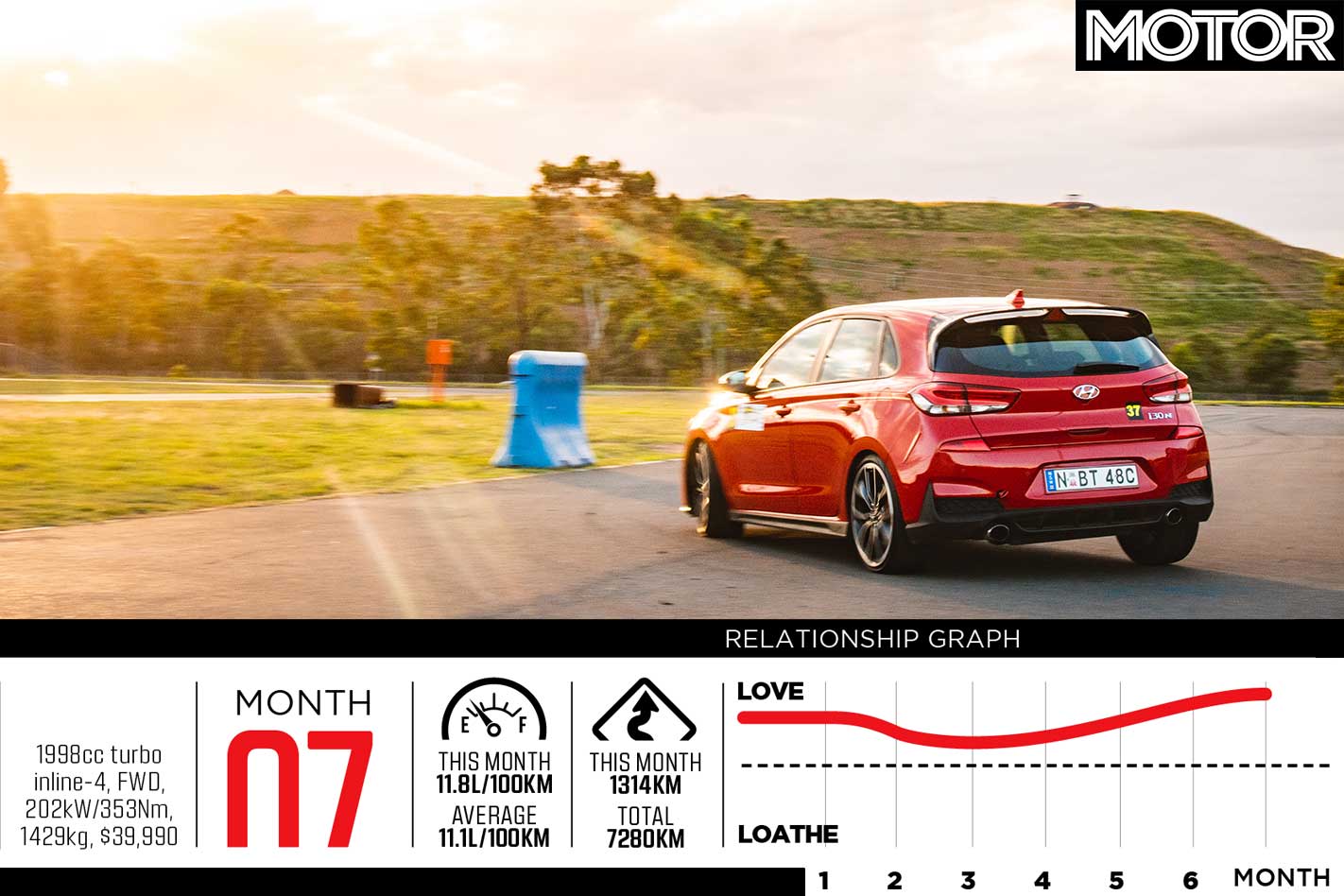
2018 Hyundai i30 N Pros & Cons
Three things we’re falling for: 1 – Extra grip 2 – Performance 3 – Competition
Three things we’re not fond of: 1 – Post-rally blues 2 – Road/tyre noise 3 – Turning circle
Update 7: Conclusion
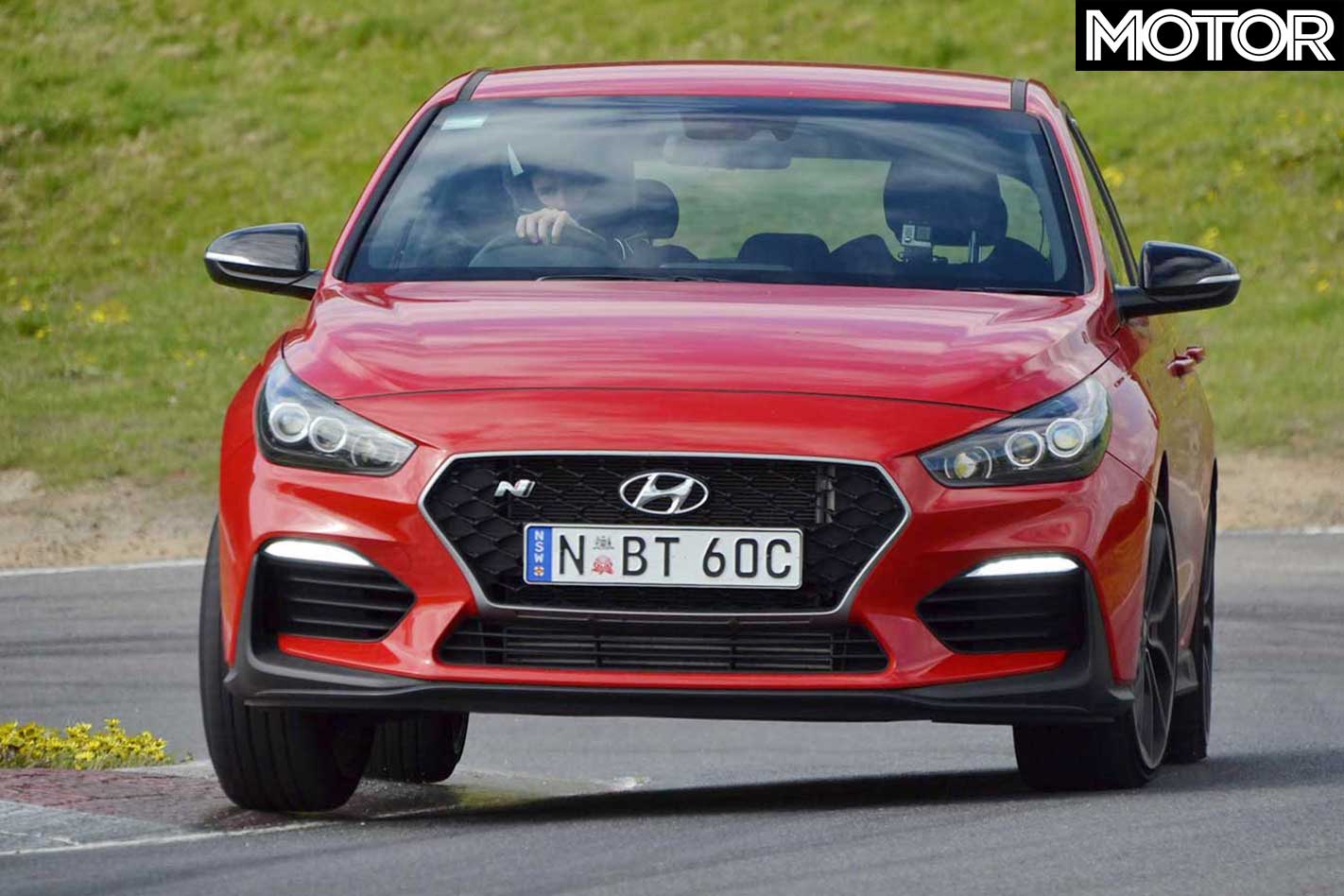
Some cars shine in isolation, only for their foibles to become clear in comparison to their rivals. The Hyundai i30 N is in the opposite camp; it certainly feels like a very polished hot hatch in isolation, but only when you drive it in the context of other performance machinery do you realise what a high level it achieves.
This has been a more thorough long-term test than most, partly because of the i30 N’s broad abilities and partly because as one of last year’s most important releases, we felt it was important to put this newcomer through the wringer, so to speak.
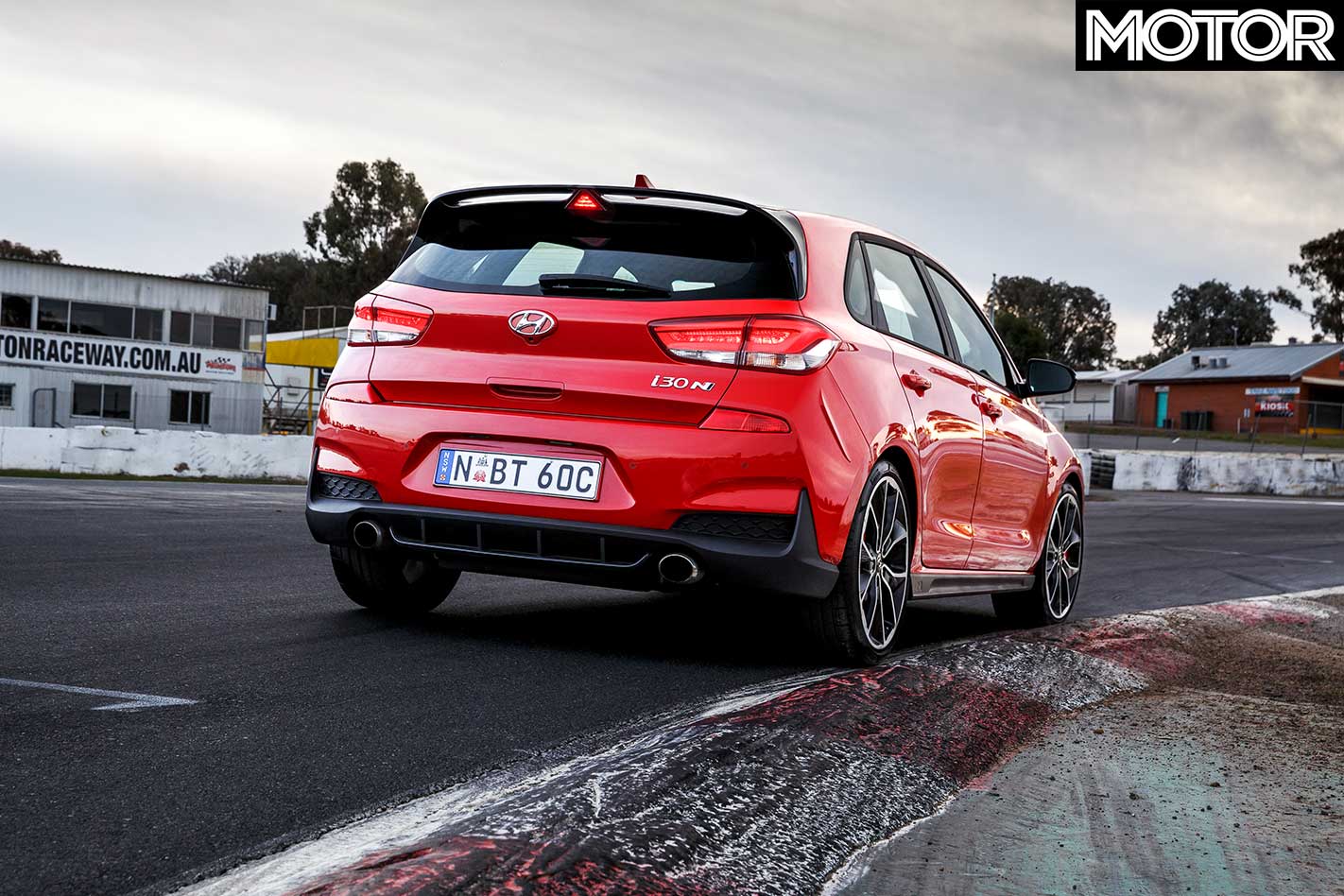
As well as appearing at Bang For Your Bucks and Performance Car of the Year, six months spent with ‘my’ i30 N included more than 7000km of road testing, a comparison test against its closest rivals, straight-line performance testing, track testing at Sandown and Winton and club-level competition in a hillclimb and a tarmac rallysprint.
As such, we feel well placed to deliver a definitive verdict on Hyundai’s first hottie: it’s excellent. Let’s explain why, bit by bit. The drivetrain is the i30 N’s weakest link. Its on-paper stats of 202kW and 353Nm, with 378Nm available on overboost, are impressive, and the 0-100km/h claim of 6.2sec is competitive given the sole choice of a six-speed manual gearbox.
On the road the engine is very effective. Response is excellent and the broad spread of mid-range torque from 2000-5000rpm gives it the ability to pull vigorously out of almost any corner. On track it’s less impressive, the smaller turbo that’s responsible for the quick build-up of boost running out of puff beyond 5500rpm. If there has to be a trade-off, it’s difficult to argue with Hyundai’s decision to prioritise road flexibility over redline fireworks.

That said, I wish it sounded a bit better. The vicious rally car-style pops and bangs on the over-run are nice, but were they made so overt to distract from the fact that the basic engine noise isn’t anything special? Overall, the engine is solid but nothing amazing.
The gearbox fares similarly. Overall the shift quality is very nice, with each successive gear selected with a flick of the wrist. The i30 N is an easy car to stall, though; when I first wrote this I got an earbashing from Hyundai PR but pretty much everyone in the MOTOR office is in agreement.
The fact that the first thing Rick Kelly did behind the wheel of the i30 N at PCOTY was stall it means I’m sticking by the assessment. It has anti-stall software but it’s not strong enough to use no throttle and I suspect applying any throttle manually deactivates the ‘help’. No big deal, but it requires acclimation.

Another bugbear was the gear lever occasionally getting caught on the 5-6 shift; it’s the work of a moment to find similar complaints on i30 N owners’ forums around the world so it’s a common issue.
Again, not a huge drama, but annoying, as is the large gap between second and third gear. Second is short, ending at 99km/h, whereas third is quite tall, stretching to 149km/h. Did Hyundai choose a short second to improve the 0-60mph (97km/h) time, or was it the only gearset available?
Not sure, but it hampers the 0-100km/h time, as does the non-killable traction control in first gear, which cuts in to tame the vicious axle tramp and keep the driveshafts and CVs in one piece. A slightly longer second gear would make the i30 quicker against the clock but, far more importantly, better to drive.
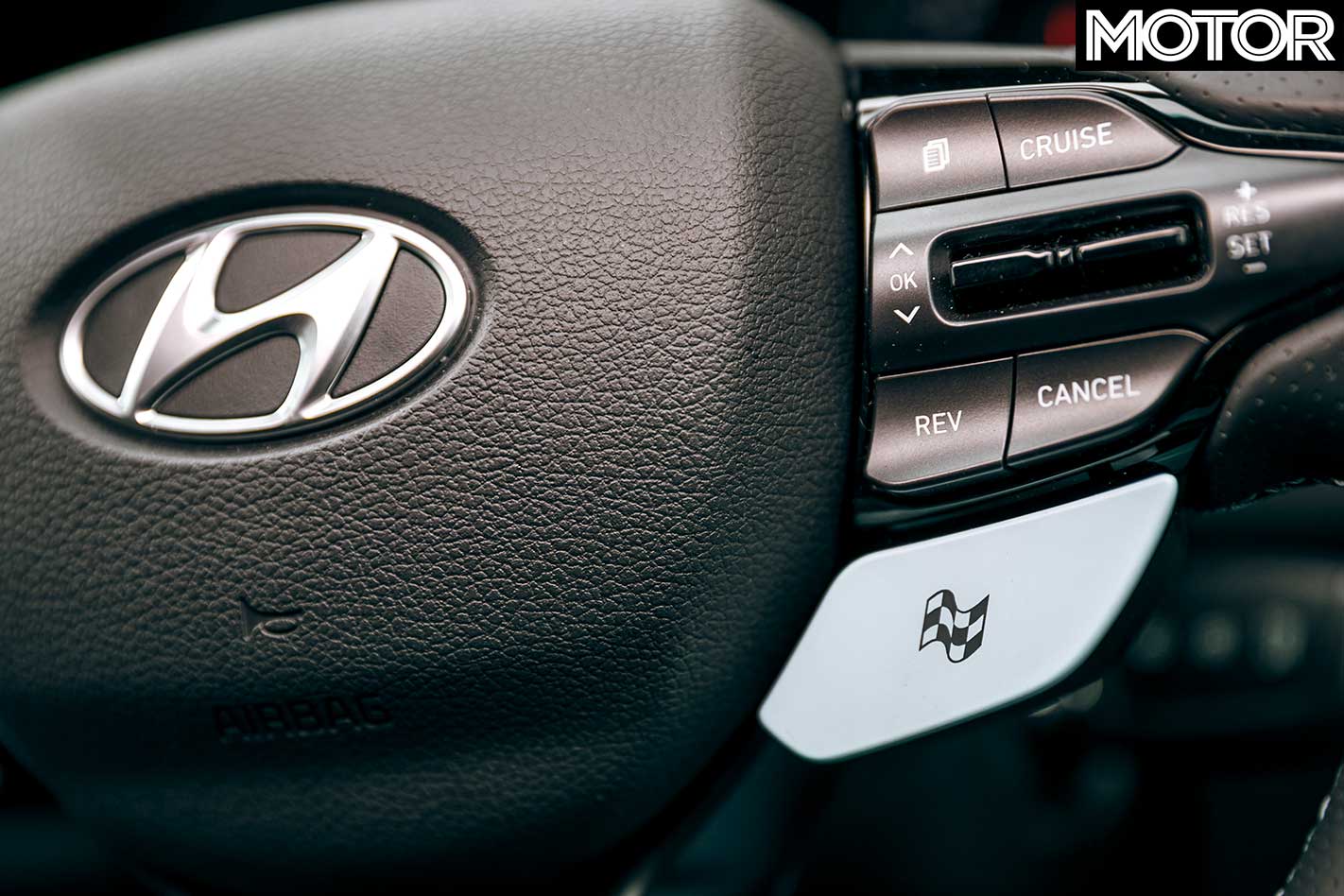
And that’s saying something, because it’s already fantastic. On road or track, you’re guaranteed to get out of an i30 N with a massive grin on your face and probably have to wait for whoever you’re driving with to catch up.
It’s precise and grippy yet also adjustable, with strong brakes and a great front-end courtesy of that electronically-controlled limited-slip diff. The i30 N’s interior is a bit plain (though very functional, I have no complaints) because Hyundai spent the money on the mechanicals and the decision has paid huge dividends. Ideally, there’d be a little more ride comfort; the new i30 N Fastback has a softer setup and it’ll be interesting to see if this carries over to the hatch.
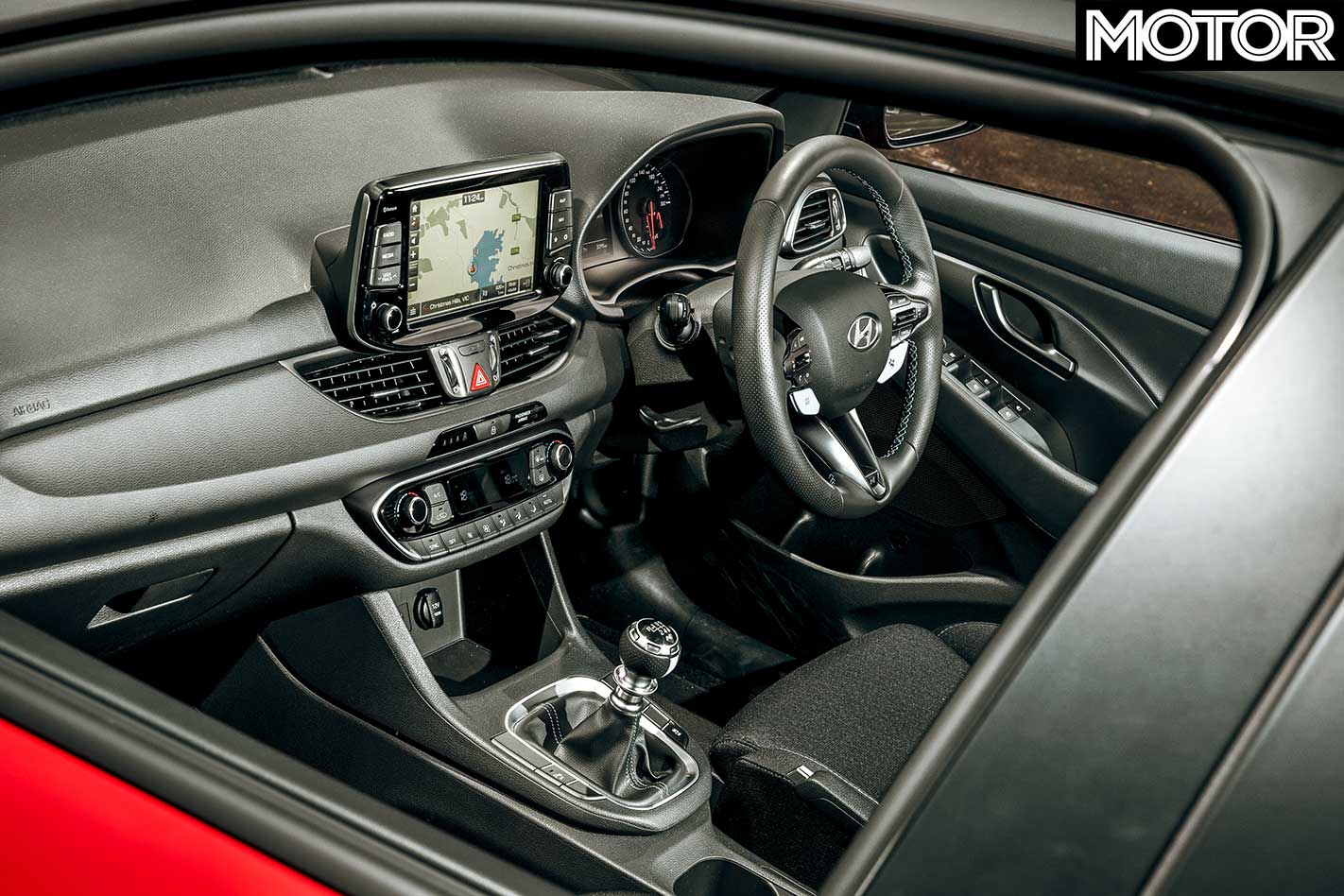
Hyundai has talked up the track day prowess of its first hot hatch and, by and large, the i30 N delivers. If you’re a regular circuit goer we’d recommend racier brake pads and better fluid as the brakes on NBT 60C were pretty tired by the end of our loan. Likewise, a set of semi-slicks will increase your enjoyment as the stock camber settings don’t let the standard Pirellis bite into the tarmac hard enough. Best of all, neither track use or the fitment of sticky tyres will void your warranty.
For a first attempt, the i30 N is a stunning achievement. It’s the perfect hot hatch: practical and undemanding in everyday use, yet it comes alive at the first sniff of a twisty road. All for $40K or so before on-road costs. There are minor flaws, but none are deal breakers and most probably already being rectified for future updates. We’d say Hyundai is set to feature towards the pointy end of the hot hatch segment for years to come.
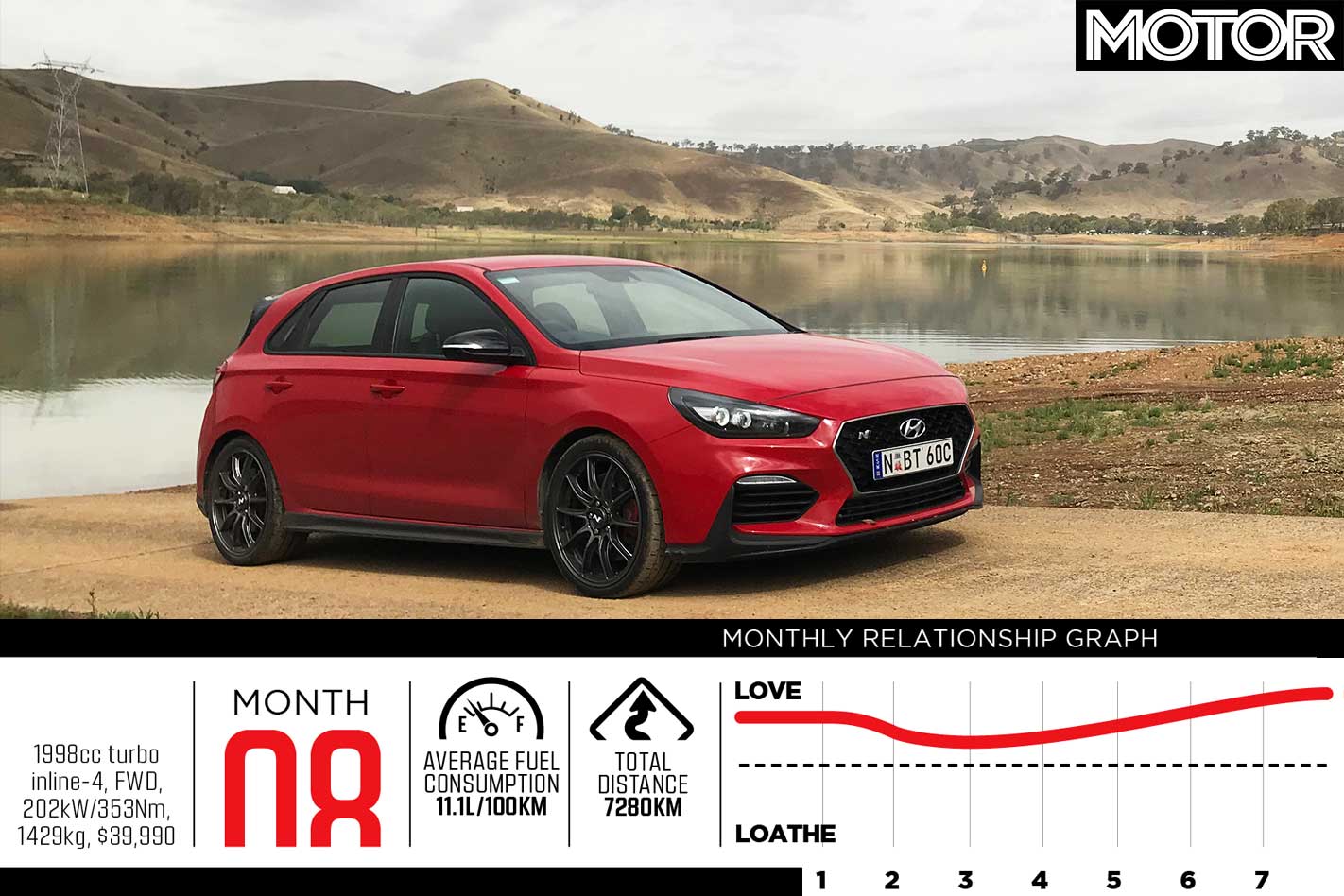
2018 Hyundai i30 N Pros & Cons
Three things that need to stay 1 – Adjustable chassis 2 – Stamina 3 – Broad powerband
Three jobs for facelift time: 1 – Revise gearbox 2 – Engine sound 3 – Jazz up interior


